#but both use a lunar calendar format
Explore tagged Tumblr posts
Text
Why is it so difficult to find a lunar calendar from the 10th century? I don't think I'm asking for too much
#ace writes sometimes#writing problems#JOML#ALoM verse#me for absolutely no reason whatsoever: let me find out what their native month would have been#me realising that lunar calendars were obviously the format for calendars back then: hmm thats a whole completely different format#well that doesnt translate very well#guess ill just make my own lunar calendar for fic purposes <- totally sane thought process#baring in mind that kol and renata have different calendars to each other as well because they have different backgrounds#but both use a lunar calendar format
3 notes
·
View notes
Text

Because I love worldbuilding so much, I decided to create an Ozian Calendar and thought I'd share it.
The Ozian day is 26 hours long, there are seven days in a week, twelve weeks in a season, and four seasons in a year, leading to 336 days in a year. Each year is symmetrical, each day falling on the same day of the week without fail. The days of the week are named after seven of Lurline’s fairies who helped her construct Oz in the beginning when everything still needed moving along. The Calendar is based on the Lunar cycle.
The names of Lurline's fairies who helped her form Oz: Mona, Tuesin, Wednessa, Thur, Fridda, Saturno, and Sun.
The format for the Ozian Calendar is read DAY SEASON YEAR. Before the Wizard of Oz took over, the calendar followed the Ozma Dynasty so it would read 54 SPRING 3104 Y.O.L.O (or Year of Our Lady Ozma). After Oscar takes over the format is 54 SPRING 1 D.O. (or Dynasty of Oz)
Note: This list of holidays and their dates are not canon or comprehensive. You don’t have to use any of these or you can come up with your own. I’d love to hear about them.
HOLIDAYS under the cut
New Years Day/Winter Solstice: 1 WINTER
Vinkun Festival of Lights: 84 AUTUMN - 7 WINTER
The Festival of Lights lasts eight days and celebrates both the end of the Ozian Calendar year. Over the course of the festival, candles are slowly lit adding one each night to represent the days getting longer and hopes of a good spring. Some areas go to temples to make wishes and ask for good fortune for the New Year while other areas release paper lanterns with their wishes written inside.
Lurlinemas: 6-7 WINTER (Ozian version of Christmas)
Day of Queens: 15 WINTER
In some sections of Oz, this is the day children are given presents instead of on Lurlinemas. Schools use this day to host pageants and talent shows.
St. Amora’s Day: 43 WINTER
Amora was a matchmaker who would bring couples together and help them fall in love by using enchanted arrows. She fell in love with a mortal man, but her arrows didn’t work on him so she had to woo him the old fashioned way. She presented him with sweet smelling flowers to make his days bright and fragrant and sugared dates and honeyed nuts to give him sweetness, and though she was busy she set aside time to be with him. They fell in love, but the day they were meant to be wed, he was killed. Every anniversary, she brought flowers and sweets to his grave. She never loved again, her heart bleeding so much, her bird companions offered to share her pain. Tradition lives on in showing your sweetheart that you care about them by giving flowers and sweets and decorations of hearts and punays.
Discount Candy Day: 44 WINTER
St. Rependi’s Day: 71 WINTER
Brother to St. Amora, represents requited (or unrequited) love. This day is used to give return presents (or dish out rejections) given by admirers on St. Amora’s day
Spring Equinox: 1 SPRING
St. Platonia’s Day: 15 SPRING
A day for children to show appreciation to their parents.
Earth Day: 43 SPRING
Deemed the day to celebrate the creation of Oz. Usually spent by showing appreciation to nature which now moves by itself rather than needing help by Lurline’s fairies to move along.
Cotillion (Munchkinland): 61-63 SPRING
Traditionally for matchmaking, now used as one big debutante ball for all who have come of age in the past year. Wealthier families have balls for one child, though it’s more common to wait for Cotillion so everyone enters the season together.
Vinkun Festival of Trees: 40-43 SPRING
Gillikin Spring Festival: 40-47 SPRING
Munchkin Spring Festival: 40-46 SPRING
Vinkun Poppy Festival: 67 SPRING
Summer Solstice: 1 SUMMER
Vinkun Summer Solstice Festival: 1 - 8 SUMMER
Festival begun to hope for a good harvest in the autumn. Celebrated with bonfires, dancing, and good food. Midway point of festival a sacrifice is offered up in the bonfire. Since Great Drought the “sacrifice” is a bundle of grass and a wooden animal. Second to last day is spent fasting and at temples, final day has a huge feast. More devout households and the temples will begin the festival with eight candles and extinguish one each day to represent the days becoming shorter and to remind that the days of plenty are temporary just as the lean days are.
Music Festival (Quadling Country): 78 SUMMER
Autumn Equinox: 1 AUTUMN
Wizard Arrival Day: 2 AUTUMN
Vinkun Harvest Festival: 36-42 AUTUMN
Celebrates end of the harvest and is traditionally a way for tribes to get together to exchange goods. People clean their homes and prepare for winter during this time
St. Sowren’s Day: 43 AUTUMN
On this day, the realms of Oz would shift where the angels and fairies could not cross into Oz, but the creatures of the demon realm could, leaving them unchecked. St. Sowren was left behind before they could return to their realm and they discovered that by donning frightening masks and offering up sweets to anyone scary enough, the demons grew confused and would leave the disguised alone, suspicious of their gifts.
Gillikin custom dictates this is a day to visit family graves and shrines which they clean and leave offerings on inviting their deceased loved ones home for the evening for a party. A day of remembrance. In the last century, costumes are also worn by children to collect treats (part of their haul is shared with their family) or by adults for parties.
Ozma De-throned Day: 68 AUTUMN
New Year’s Eve: 84 AUTUMN
24 notes
·
View notes
Text
History, Evolution, and Diversity of Western Astrology
The Allegorical Heavens of Mesopotamia, Chaldea, Egypt, and Greece
Today, in the Río de la Plata region, we informally celebrate Astrologer's Day. This day was established by Boris Cristoff in the distant year of '87 to break the stigma surrounding the practice of Astrology and related disciplines. It secularizes the celebration of the Christian Epiphany associated with the Three Wise Men.

I took the trouble to investigate whether Cristoff was a Christian man, but neither the press where he worked for so many years nor what I could read in some of his books showed the slightest evidence that this was possible. Instead, he seemed to exude secularity, as any good Uruguayan enthusiast might. Thus, Boris decided to secularize three mythological astrologers to honor the profession for which he left behind a career in architecture.
Additionally, it appears that a supposedly global association of astrologers has had its international day established on the vernal equinox since the '90s. However, my research revealed that they do not give it as much importance as we Uruguayans and Argentinians do on this day.
So, Happy Astrologer's Day! A warm hug to the watchers of the constellations, lunar mathematicians, and star decoders. I also celebrate my own art, Magick, and its artists—the magicians, weavers of the invisible, illusionists of the ether, and multipliers of doors.
The journey of Astrology begins with humanity gazing at the night sky in search of answers to the mysteries of existence. At its core, observing the stars is a silent dialogue between ephemeral human hopes and the vast Cosmos.
In general terms, we can say that Astrology, as we know it, took its current form in classical Greece. It was precisely in Greece, between the 2nd and 1st centuries BCE, that the concept of an astrological chart or natal chart was developed. Although its historical roots are in the Mesopotamian civilizations, this original Astrology did not include planets, signs, or houses as we know them today. Instead, it used the relative positions of planets concerning star formations as oracles applied to events of nations rather than individuals.
Another significant component of Greek Astrology, in addition to the Mesopotamian influence, is the Egyptian aspect. However, the Astrology of the Egyptian civilization also did not have signs or houses. It was almost entirely sidereal – that is, related to the stars – and was not used for personal predictions but rather to understand the destiny of the nation personified by the Pharaoh and for sacred ceremonial rites.
Both Mesopotamian and Egyptian forms of Astrology focused primarily on predicting the cycles of floods, river overflows, and the sowing calendar – all crucial events for the survival and prosperity of these civilizations. In modern Astrology, Mars and Saturn are still considered "malefic planets" because, in the Sumerian calendar, they were visible during the dry season, associated with death.
Classical Greek civilization, and later Hellenistic, granted Astrology the role of predicting individual destinies. From Ptolemy's era, the current form of modern Astrology is recognizable. Ptolemy's great work was to systematize Astrology, stripping it of the superstitious elements of archaic religious character to make it compatible with the philosophies of Aristotle and Plato, adopting a more rational view of the cosmos.
The Tropical Zodiac
There are significant differences between the tropical zodiac and the constellations that gave rise to the names of the zodiac signs. The tropical zodiac is defined symbolically and mathematically from a specific point in the sky: the origin point of the coordinate system, or 0 degrees Aries, which is the intersection between the celestial equator – the extension into the sky of Earth's equator – and the Earth's orbital plane, known in ancient terms as the apparent path of the Sun along the year against the backdrop of fixed stars at the March equinox. With this definition – starting from the spring equinox in the northern hemisphere – the tropical astrological year correlates stably with the vernal point, the seasons, and the tropics, hence its name.
The zodiac signs are 30° segments on the ecliptic, occupying equal plots established by dividing the 360° ecliptic into 30°. The symbolic characteristics related to the interpretation of the signs are divorced from the constellations that gave them their names during the Greek period. This is the system used by the vast majority of Western astrologers today.
Depending on how the sky is divided, the constellations can overlap in different ways. The ecliptic crosses more than 12 constellations, and which ones to consider has been a topic of discussion for centuries. The tropical system, on the other hand, is an idealization to achieve a perfect, repeatable system without adjustments that result in arbitrary interpretations.
The astronomical phenomenon known as the precession of the equinoxes was already known at least since the 1st century BCE among the Mesopotamian civilizations. In Greece, its discovery and measurement are attributed to Hipparchus of Nicea. Because the precession of the equinoxes is a notable effect over time – 50.3 arc seconds per tropical year – and the 0-point of the Aries constellation varies according to the system adopted by the interpreter, the tropical system is considered more rational and precise in its measurements, even though it is an idealized and simplified model.
The Main Orientations of Modern Astrology
Today, Astrology has two main trends that use the same tools but adopt different approaches: humanistic Astrology, focused on describing personal factors in natal charts and psychological tools; and rational Astrology, focused on predictive aspects.
The zodiac and its signs, the planets – including celestial bodies not considered planets by science like the Sun, Moon, Pluto, asteroids, certain mathematical points, etc. – and houses are symbolic constructs for both astrological trends. The planetary positions used are the real apparent positions, but the interpretive context known as signs comes from the tropical zodiac.
A minority of Western astrologers seek to reintroduce sidereal Astrology into traditional Astrology. Specifically, they aim to use real constellations with a zodiac not synchronized with the seasons but with the background stars. Interpretatively, this represents a return to a mechanistic view, establishing a causal relationship between the planets and human behavior on Earth – ideas that Astrology abandoned a couple of millennia ago. The notion that Astrology serves to predict people's destinies is what critics of Astrology, who know nothing about it but want to appear critical, rational, and intelligent (more intelligent than others), still think. It is also what some horoscope enthusiasts believe. It is curious that, more than two thousand years after being abandoned, both Astrology's harshest critics and its most ardent believers share this ridiculous belief.
The mechanical problems that sidereal Astrology currently faces are the same as in ancient times, namely: constellations vary in size and overlap; the width of the zodiacal band is variable; signs can be more or fewer than twelve and do not always correspond with fixed calendar dates; the system's starting point can change at the astrologer's discretion. These discrepancies also bring interpretative problems in deterministic issues and due to the lack of firm tradition, making it difficult to assign meanings if new signs and variables are continually added ( Let's be honest: there aren't many astrologers with scientific inclination and/or resources to dedicate their entire lives to serious Astrological studies with modern tools)
However, there are sidereal astrological variants such as Chinese and Hindu Astrology that do work, but it's important to understand that their approach is not individual as in Western Astrology. Trying to interpret Eastern Astrology in a personal context is similar to the issue of trying to import karma and other Eastern concepts into our Western religions, including pagan ones.
Some Conclusions on Astrology
Astrology is symbolic. It uses the tropical zodiac because it physically correlates with the solar year, is mathematically consistent, is philosophically adequate for predictions, and generates a poetic language rich enough to be a common symbolic substrate for many people.
Western sidereal Astrology, though minor, exists. This trend revives the idea that constellations and planets have a causal influence on people.
Eastern sidereal Astrology also exists. It doesn't have the same focus as Western Astrology, and attempting to use it for horoscopes is as problematic as trying to fit any Eastern concept into the West.
Modern Western Astrology is neither causal nor deterministic. Despite the language it uses, Astrology is closer to the principle of correspondence. Among the two predominant trends in modern Western Astrology, most astrologers are humanistic, focusing on the psychological and introspective aspects of human beings, not on predictions (nor technical research).
There are ways to convert a tropical natal chart to sidereal zodiac systems. These calculations are complicated, and that's why there aren't simple tables floating around the web like there are with horoscopes, each more ridiculous than the last.
Astrology didn't get stuck in Antiquity, the Middle Ages, nor the Renaissance sages. There are ancient branches of Astrology that remain very useful, but there are also new ways of interpreting the sky and zodiacal cycles. Astrology is a diverse art, with many serious practitioners, and many more who aren't as serious.
Astrology in Western Magical Systems
In 3rd-century Gnostic Alexandria, Hebrew Kabbalists compiling the Sefer Yetzirah considered Astrology, due to its similarities with Kabbalah, as one of the great spheres of symbolic correspondences between the Microcosm and the Macrocosm. If Astrology and Kabbalah have something in common, it's the idea that each person has good or bad luck based on how they leverage their conditions and circumstances. Practically, Kabbalists found equivalences between the twelve signs, houses, conjunctions, oppositions, and elemental associations with the structure of the Tree of Life. Although they share similarities, Kabbalah and Astrology also have differences, especially philosophical ones. The most immediate is that Astrology fascinates by referring to a more personal orbit, while Kabbalah is transpersonal, metaphysical.
Over the centuries, rationalism discarded the web of symbolic relationships and analogies that Astrology had woven as an allegorical map, confining it to the realm of superstition. It wasn't until the last century that Carl G. Jung validated it as the atavistic imprint of our cultural patterns with his theory of archetypes.
Astrology is a model of knowledge that doesn't deserve the sad fate of oblivion, nor to be reduced to the star ephemerides of black horoscopes because it belongs to the sphere of mythical-symbolic knowledge, like the Arts. If intellectual laziness – often disguised as inner freedom – doesn't produce good botanists, good cooks, or good electricians, why would it produce good magicians, good tarot readers, good astrologers? A minimum of Astrology knowledge allows for a better interpretation of the Tarot, especially of decks from orders like the Golden Dawn or some of their followers, like the Rider-Waite-Smith deck, the most popular in the world.
Many people don't have the money for a course, but they can start by ignoring horoscopes and other astrological nonsense. In this century, we have the opportunity to learn like never before, and we can reflect on the freedom we have in the destiny
#uruguay#montevideo#magick#tarot por kema#witches of tumblr#occult#día del astrólogo#astrology#astrologers#pagan#witchblr#witch community#astro tarot#birth chart#astrology signs#zodiac signs#witchcore
0 notes
Text
Get Ready for The Crust Factory: Building Humanity's Future on the Moon

The Crust factory building simulator game has sights on Linux and Mac with Windows PC. Thanks to the talented team at VEOM Studio for bringing this title to life. Due to make its way onto Steam Early Access soon. Publisher Crytivo and VEOM Studio have announced the release date for their lunar automation factory building simulator, The Crust. Mark your calendars for July 15th, 2024, because that's when you can start exploring humanity's future home on the moon in Early Access. Due to complete the roadmap within 8-12 months, so there's plenty of time to get in early and watch the game grow. But here is what is happening with The Crust factory building native support:
We are currently focusing on the upcoming release, but after that we will be busy with Linux and MacOs support.
In an email from VEOM, the developers mentioned they're aware that some players are running the game on Linux using Proton, and it's working. They're also planning a native Linux build since the game uses Unreal Engine 5, but there's no ETA for it yet.
The Crust factory building Trailer
youtube
Fresh off their Kickstarter success, The Crust lets you dive into a world where you’ll manage both factories and colonists. Think Rimworld and Factorio vibes, but on the moon, with humanity struggling back on Earth.
What can you do:
Mine and manage resources: Dig deep underground or scour the lunar surface for valuable materials.
Build and automate factories: Use conveyor belts, distributors, and underground systems to keep resources flowing.
Unlock new tech: Explore three research trees with over 50 different researches to advance your moon base.
Experience multilevel play: Work on the moon's surface, dig underground, and manage from a global satellite view.
Manage a team of experts: Each specialist has unique skills to boost output and research. So you’ll need to keep them happy and healthy.
Lead expeditions: Discover the moon’s secrets by exploring remote objects. There are abandoned building and unique geological formations.
Trade resources: Deal with tough factions to get the best materials and items for your base.
Choose your mode: Whether you’re into Campaign mode or prefer the factory building freedom of Sandbox mode, The Crust has you covered.
You’ll start by mining and converting resources due to ensure a steady flow of materials. Set up your advanced mining building with Subsurface Mining and build vital processing on the Lunar Surface. While you uncover hidden resources via Satellite View. One of the best features is managing your team of scientists and specialists. They’re not just there to work; you need to look after their well-being, needs, and abilities to keep your moon base running smoothly. This means setting up a suitable habitat where they can live, work, and thrive. Your lunar conquest doesn’t stop there. Lead journeys to explore the moon’s mysteries, trade with different factions, and optimize your production and research efforts. The more you play, the more you uncover, making each session a unique adventure.
The Release:
So, get ready to lead humanity’s next big leap. The Crust factory building simulator is coming to Steam Early Access on July 15th. Jump into Early Access, and be part of the journey as the game evolves over the next 8-12 months. Starting, on Windows PC, but due to evolve onto Linux as well as Mac. Whether you’re a fan of factory sims, colony management, or just like the idea of a building simulator on the moon, The Crust has something for you.
#the crust#factory building#simulator#linux#gaming news#veom studio#ubuntu#mac#windows#pc#unreal engine 5#Youtube
0 notes
Text

The Moon orbits Earth at an average distance of 384,400 km (238,900 mi), or about 30 times Earth's diameter. Its gravitational influence is the main driver of Earth's tides and very slowly lengthens Earth's day. The Moon's orbit around Earth has a sidereal period of 27.3 days. During each synodic period of 29.5 days, the amount of visible surface illuminated by the Sun varies from none up to 100%, resulting in lunar phases that form the basis for the months of a lunar calendar. The Moon is tidally locked to Earth, which means that the length of a full rotation of the Moon on its own axis causes its same side (the near side) to always face Earth, and the somewhat longer lunar day is the same as the synodic period. Due to cyclical shifts in perspective (libration), 59% of the lunar surface is visible from Earth.
The most widely accepted origin explanation posits that the Moon formed 4.51 billion years ago, not long after Earth's formation, out of the debris from a giant impact between Earth and a hypothesized Mars-sized body called Theia. It receded to a wider orbit because of tidal interaction with the Earth. The near side of the Moon is marked by dark volcanic maria ("seas"), which fill the spaces between bright ancient crustal highlands and prominent impact craters. Most of the large impact basins and mare surfaces were in place by the end of the Imbrian period, some three billion years ago. Although the reflectance of the lunar surface is low (comparable to that of asphalt), its large angular diameter makes the full moon the brightest celestial object in the night sky. The Moon's apparent size is nearly the same as that of the Sun, allowing it to cover the Sun almost completely during a total solar eclipse.
Both the Moon's prominence in Earth's sky and its regular cycle of phases have provided cultural references and influences for human societies throughout history. Such influences can be found in language, calendar systems, art, and mythology. The first artificial object to reach the Moon was the Soviet Union's uncrewed Luna 2 spacecraft in 1959; this was followed by the first successful soft landing by Luna 9 in 1966. The only human lunar missions to date have been those of the United States' Apollo program, which landed twelve men on the surface between 1969 and 1972. These and later uncrewed missions returned lunar rocks that have been used to develop a detailed geological understanding of the Moon's origins, internal structure, and subsequent history. The Moon is the only celestial body visited by humans.
our thread : https://m.facebook.com/story.php?story_fbid=pfbid0zooy979YrYXaX1EngwD2v1GGoj1v8vaFvRe3gyT95PUm7Bu1EpnKMDGFhZRuG8UFl&id=105574388883799&mibextid=Nif5oz
🌙 : https://www.facebook.com/selephilerelleodet
0 notes
Text
Organizing worship
I wasn't sure I wanted to post about this but maybe it can inspire others.
Several months ago when I decided to completely change my worship with a new calendar, a new set of festivals, and overall a ton of new things, it became more and more obvious to me that having all the information I needed for celebrations only in digital format was not going to do it.
Having to twist my neck to look at my laptop or phone screen when I couldn't remember hymns from the top of my head was already something I found to be a small inconvenience and made me prefer to have physical copies of the hymns. Only, that doesn't work anymore when half of the hymns you need to recite are your own.
So I had two choices, start a notebook or put something together. Since I can't reread my own handwriting for the life of me, I went with option number 2, made a book for my own use, and had it printed on command.
I'm very happy with the result, and I'm glad to share how it looks, but mostly, if there's any value in me sharing this, it's to explain how it's organized.


The first section is reserved for all the festivals. My calendar has 26 of them scattered throughout the year. For each of them, this is the information I included:
Date: since I follow the lunar calendar, I only included the date in the Greek format. This way the book doesn't give erroneous dates in the years to come. I track the days through my digital calendar anyway.
Gods and relevant epithets for the festival
A short summary of what the festival is about: this is both to have a reminder but also to keep track of the modernizations I have made and based on what historical ground.
List of offerings and libations
Hymn(s) recited/sung: some are Homeric, others are ones written by myself.
Recipe for the main offering/feast

The second, and much smaller section served to finally put together all the hymns needed for the monthly observances and the various other smaller sacred days included in my calendar that are not full-blown festivals. The layout is very similar for them, except that they do not have recipes linked to them.
It's so much more convenient than waking up your phone screen every 20 seconds, but the other benefit I've found is that putting this together really forces you to look at the blind spots in your worship and take care of them.
If there's something to take away from this rambly post is simply that putting things down on paper somehow really really helps. Or at least, it helped me immensely in having a sense of knowing what the hell I'm doing.
161 notes
·
View notes
Text
Astralignment
and the Korribani Calendar System
Before the arrival of the Exiles the native Sith on Korriban had their own system of keeping track of time. Over the years, this became standardized and refined and is still in use by a large portion of the modern Pureblood community. Since the ancient Sith were observant beings of their world, many of the names and symbols reflected their natural environment. All of these aspects go into what is known as a Sith’s astralignment (astro-alignment).
Since the Empire runs on Imperial Standard Time (IST), anything relating to Korriban or any other Imperial world is referred by the local time of that planet.
Compare a year on Dromund Kaas to Korriban:
Dromund Kaas (everything in standard)
24 hours/day
312 days/year
7,488 hours/year
60 minutes = 1 hour
24 hours = 1 day
5 days = 1 week
7 weeks = 1 month
35 days = 1 month
8 months (+4 weeks and 4 holidays) = 1 year
312 (standard)days = 1 year
Korriban
28 (standard) hours/day
780 (local) days/year
21,840 (standard) hours/year
70 (standard and local) minutes = 1 hour
24 (local) hours = 1 day
10 (local) days = 1 week
6.5 (local) weeks = 1 month
65 (local) days = 1 month
12 (local) months = 1 year
780 (local) days = 1 year
This roughly makes 1 Korribani year approximately 2.9 [Dromund] Kaasi years.
Calendars
The days on Korriban are annotated on some versions of the Imperial calendar alongside the standard days.
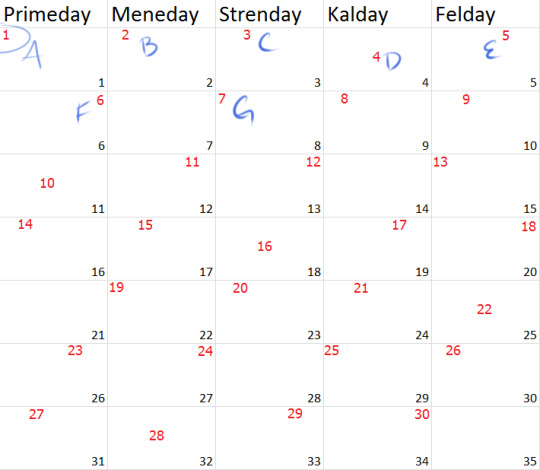
In this example, names of the days on the calendar reflect the IST. The black numbers indicate the date in IST, the red numbers represent the date of the Korribani calendar. Placement of the Korribani date indicate when that day begins in relation to the Kaasi one.
A. 00:00 is the same for both. B. 00:00 K starts at 04:00 DK. C. 00:00 K starts at 08:00 DK. D. 00:00 K starts at 12:00 DK. E. 00:00 K starts at 16:00 DK. F. 00:00 K starts at 20:00 DK. G. Loops back around and 00:00 K lines up 00:00 DK .
While seemingly complicated to some, most Sith have grown with this system of overlapping calendars and can easily tell the date by the positioning of the numbers in this format.
There are of course, electronic versions where the date is shown simply:
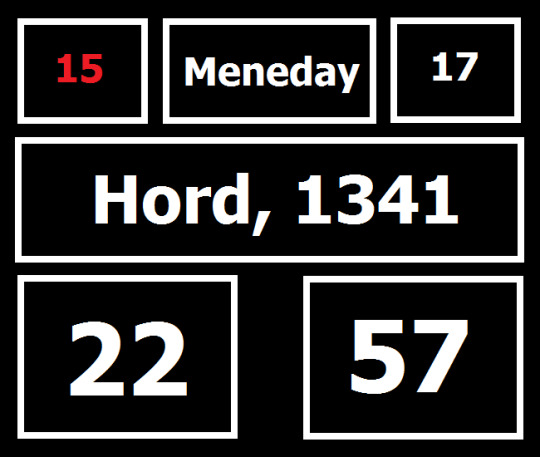
Since the Korribani month is longer than the Kaasi one, the dates will continue through the Kaasi months. These next two pictures show how long 1 Korribani month is in relation to a Kaasi one.

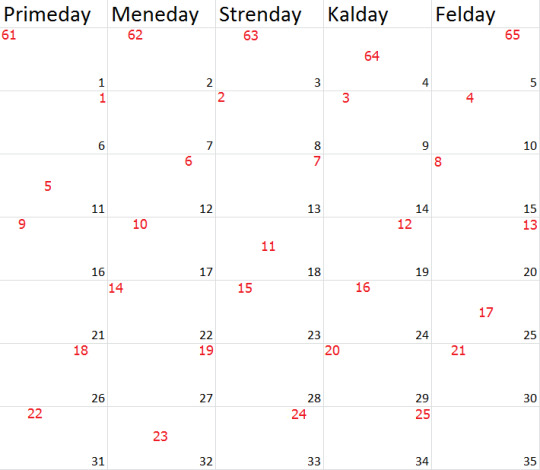
There is also a version of the Korribani calendar that does not overlap with IST. These are used locally on the planet.
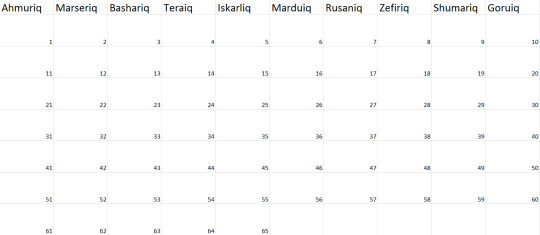
The days of the Korribani week were named after major gods from the most widespread pantheon on the planet:
Ahmuriq, from Ahmurn: the creator god.
Marseriq, from Marserha: mother goddess of the Sith.
Bashariq, from Bashara: goddess of passion.
Teraiq, from Teral: god of protection and justice.
Iskarliq, from Iskarln: god(dess) of conflict and war.
Marduriq, from Mardur: patron god of the Massassi and strength.
Rusaniq, from Rusanel: goddess of knowledge.
Zefiriq, from Zefir: goddess of the hunt.
Shumariq, from Shumari: god of the harvest.
Goruiq, from Gorul: the trickster god(dess).
Months
There are numerous constellations in the Korribani sky. Twelves of these mark the months of the year as well as going into the astalignment. The 12 major, monthly constellations all depict local fauna from ancient fables and have certain characteristics that are commonly associated with them.
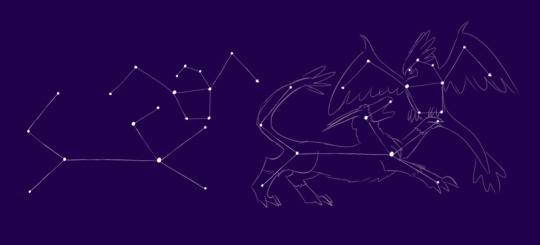
1. Yuninchâtsutuyok, the jiminat and agzonûboj engaged in eternal conflict. Dedicated, ambitious, and insightful.

2. Qyalatuyok, the qyalak. Calm, sentimental, and inquisitive.
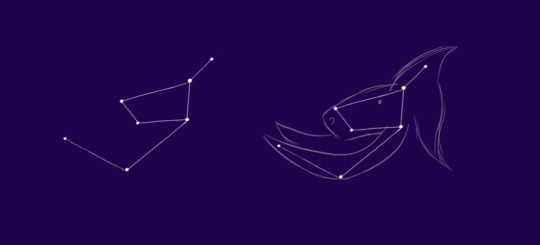
3. Badzuriqatuyok, the badzuriqash. Tenacious, practical, and direct.
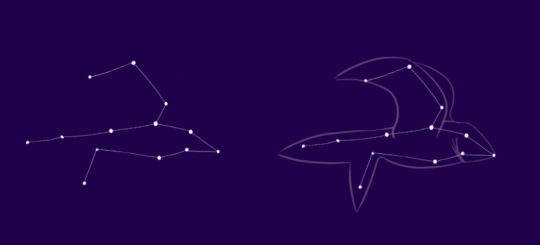
4. Kaarjontuyok, the kaarjontû. Spontaneous, contemplative, and observant.
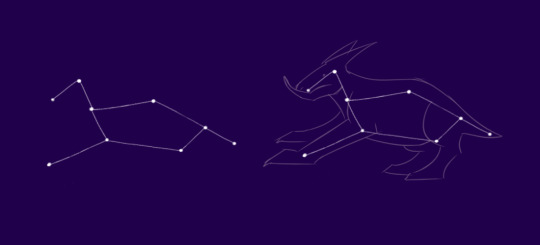
5. Tukatatuyok, the tukata. Loyal, respectful, and staunch.
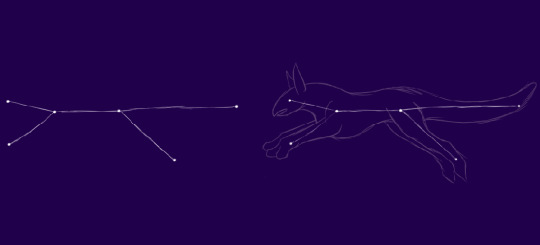
6. Hatyatuyok, the hatya. Articulate, perceptive, and adaptable.
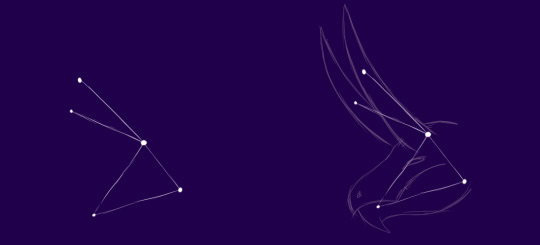
7. Lomaituyok, the lomait. Disciplined, fearless, and competitive.
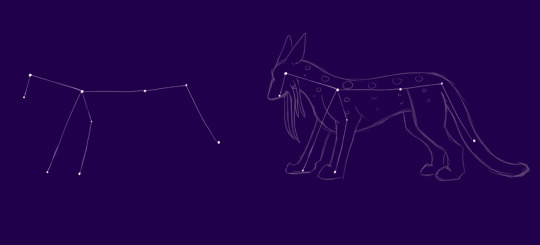
8. Dzushatuyok, the dzushaj. Private, calculating, and flexible.
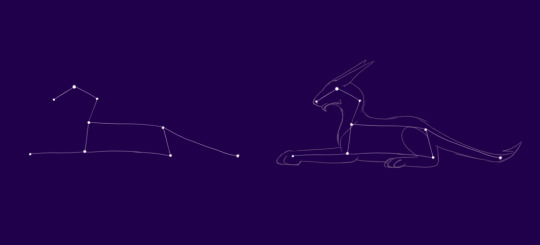
9. Mowhetuyok, the mowhef. Stern, traditional, and ruthless.
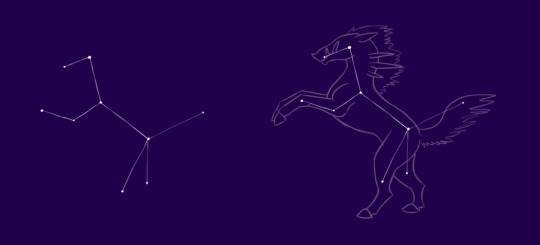
10. Dyaltituyok, the dyaltir. Mischievous, studious, and charismatic.
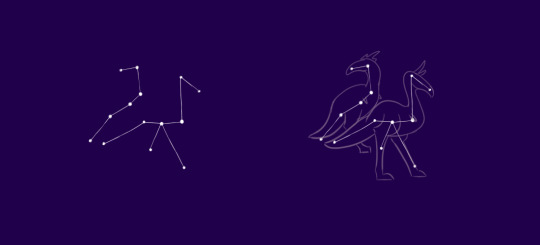
11. Jhan’dikanatuyok, the lost dikana. Creative, sociable, and resourceful.
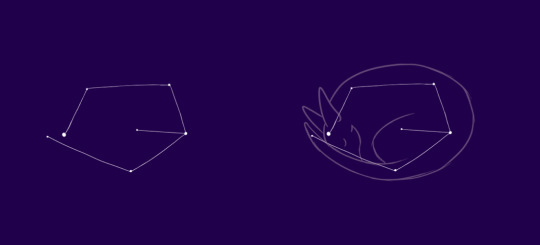
12. Niqoituyok, the niqoit. Erudite, cunning, and free-spirited.
Years
The years are also represented by local animals. No one, not even Sith scholars or historians, are sure of the origin of how these animals came to represent the years on Korriban’s calendar. It is one of the many parts of Sith culture that have been lost since it is believed this particular record has been passed down through oral tellings.
The years are kept track of in a 6-year cycle with each year emphasizing a likely success for the ones born in that year.
Chiroik - Wealth
Wokinai - Knowledge
Natûsh - Fame
Dzenal - Influence
Litskoj - Power
Sulemish - Longevity
(ie. Those born in the year of the Sulemish will have a long life.) This again factors into a Sith’s astralignment.
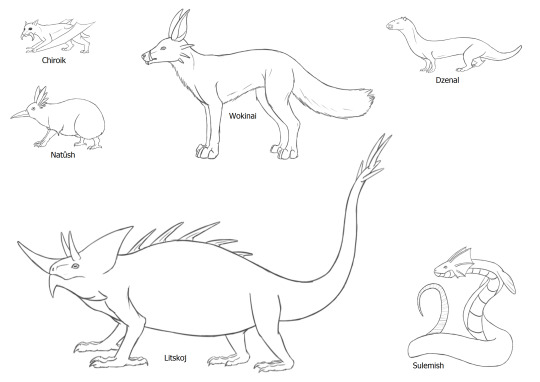
In addition to the years, these 6 animals are also used for the hours on Korriban. But time is not conveyed in the same manner as Basic. While in Basic one would simply say “14:25” (or two twenty-five in the afternoon) the Sith have a much more involved way to convey time.
For example: Shyracks screech and return to their caves as the priestess prepares the altar in the hour of the wokinai.
Translates to: 07:15 local time (or seven fifteen in the morning).
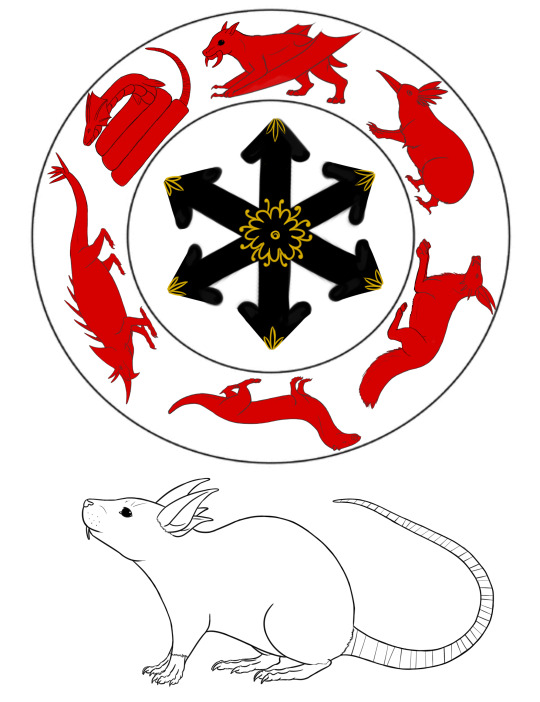
As a side note, a few centuries ago Darth Feras domesticated and bred wrats within the Empire. At first they weren’t seen with much interest by her peers. But popular rumor has it that she pointed out her creations embody the physical traits of the yearly beasts.
Eyes - Chiroik
Ears - Wokinai
Body - Natûsh
Hands - Dzenal
Feet - Litskoj
Tail - Sulemish
Afterwards they quickly became a favored pet and companion among the Sith, being seen as an auspicious animal.
While not related to their calendar there is a tradition of being assigned a birth flower. For this, the Sith do not look to their skies but rather, when a child is born the placenta is buried in a pot with 12 seeds. The first of these seeds to sprout becomes that Sith’s birth flower. These 12 flowers are also used in medicine, therapeutic or preventive, for some common ailments.
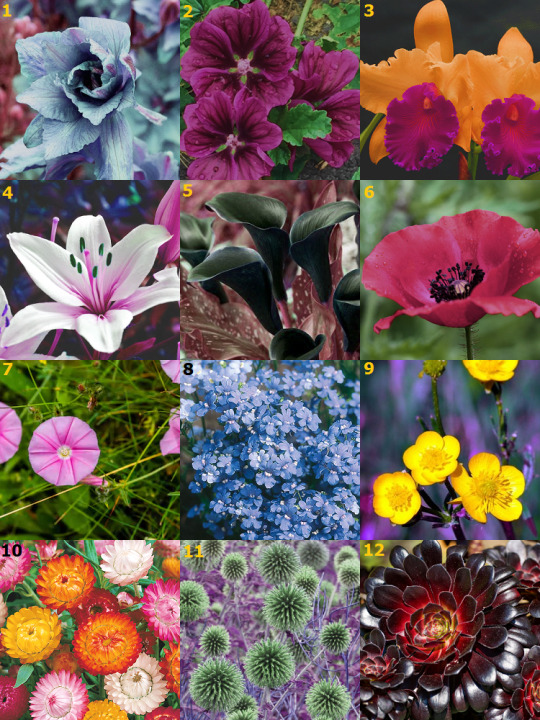
Serla for headaches.
Roshal for good eyesight.
Nashkir for sore throats.
Atsudqâ for heart health.
Hyaranjat for good digestion.
Mûyoin for muscle pain.
Shasâyar for fertility.
Jûzon for blood circulation.
Ashanin for bone mending.
Qoyo for fevers.
Chisiqsanu for irritated ridge skin.
Kûsk’inti for fatigue and replenishing energy.
The last two parts that go into a Sith’s astalignment are their energies. The weekly energies correspond with 4 classic “elements” of earth, fire, air, and water. While the daily energy simply refers to day or night (d/n) in regards to when the person was born.
Combined with all aspects mentioned in this document, year, month, weekly energy, day (+energy), and flower, one can study a Sith’s astalignment. ex. Darth Vowrawn’s astalignment factors:

The study of these astralignments is a complicated field on to its own while the findings can be very important to some among the Sith. There are specialized scholars who offer their services to the old families so that the “perfect matches” (marriage, business, or otherwise) can be set up.
— — — — — — — — — — — — — — — — — — — — — — — — — — —
aaaaahhhh!!!!!!!!!!!!!!! IT’S DONE. i feel like frodo at mt. doom after the ring is destroyed omg... ;-;
SOOOO. i wanted, and i mean REALLY wanted, to finish this for lunar new year (for pretty obvious reasons lol)...... :,) welp. then i was like “i can do may 4″ lol NOPE. but here we are! still technically sith day? whatever. imma say I Did It. :D
also pls don’t laugh at my stupid drawings. i already know i can’t art. ok??? >,<
special thanks to @snootysith for giving me a bunch of sithy names and words for me to use. c: like y’all... coming up with fake words, that look and sound ok is really HARD (for my dumbass anyway)
other worldbuilding posts that are... sorta mentioned/used in this:
@inquisitorhotpants‘s dk calendar
BOOS! x3
and some other stuff ....
but uh, yea. if you’re wondering “hang on there fluffy... did you really make a big, dumbass zodiac/astrology post??” the answer is...
yes.
yes i did... xU
but also i imagine the ancient sith had a lot of special and important dates for you know... religious things? *shrug* and over the many, many years all of this was passed down and prob altered in some way to fit into modern sith society? idk...
now imma say some things here bc i know For A Fact!!! that ppl don’t go onto original posts to read op tags on this hellsite lol.
and this isn’t me trying to sound like an arrogant asshole... but these are for some common questions that’ll undoubtedly come up:
yes, you can use this in any extent or manner.
no, you obvs don’t have to. ignore it if you want. i’ll be ok lol.
no, i’m not gonna write a long ass book with all the little details on every aspect of all the traits and then assign these things for your character(s). just make something up. that’s what i did here xD (plus my brain is d e a d from this)
yes, this is seen as a mostly(!) tomato pureblood sith thing but obvs attitudes are different between individuals. some are super into it, some could careless and think it’s all fake news, some have parents that care too much about it which is annoying and interfering with their life so they lowkey hate it lol.
no, i couldn’t do a read more bc it wouldn’t look as nice and i worked hard ok? ;-; i apologize for clogged dashes in advance.
i think that’s it? ofc feel free to hmu if you’re ok with a reply that can take anywhere from a few min to 3 business days ^-^;
#swtor#sith pureblood#sith warrior#sith inquisitor#y'all know how surprisingly hard it is to make constellations???#like...#DX#they have to look like the thing and i had to know what that Thing was#but also! have you seen rl constellations??#they don't look like The Thing at all!#so i had to make it kinda abstract? idfk#now if you'll excuse me#i'm off to be a completely unproductive member of the fandom again#:')#worldbuilding#long post
335 notes
·
View notes
Text
Tales of Aeora 1.6
🔷 Link
"An Analysis of Medeva’s poem, ‘Phrixus and Helle,’ in Relation to the Formation, and Orbit, of the Early Moons of Aeora”
By Thomas Apollinus, a member of the Society of Alchemists
Published in 622 A.D.
Summary
"The following article attempts to reconcile the debate over whether or not Medeva had access to information regarding the formation, and evolution, of the early moons of Aeora (Phrixus and Helle). There is a modern-day belief that Medeva had access to secret knowledge through her mother, Luna, and the other gods. We argue, however, that Medeva had access to exclusive records on time-reckoning, through the Society of Alchemists, and that she used complex metaphors to describe relationships that she perceived in the natural world. Unfortunately, Medeva’s advanced metaphors (and perception of the world) led many to believe that she was not entirely mortal."
Article
Contemporary scholars wonder to what extent the ancients knew about the rotation, and formation, of the moons and planets in our solar system. When “Phrixus and Helle” was written by Medeva, sometime Before the Destruction (BD), ancient astronomers relied on three methods of calculating a year – one lunar, one solar, or a hybrid depending on the civilization. The country in which Medeva lived is unknown, but historical evidence indicates that it rested somewhere between the ancient empires of Kemet and Valentia (1). The system of time reckoning for both of these civilizations is beyond the scope of this essay, but it should suffice to say that Kemet relied (primarily) on a lunar calendar while Valentia dated their months according to the sun (2). Claims by Medeva, and her supporters, that the poem was presented to her by the spirits of the two moons – Phrixus and Helle – has prevailed into modern theological discourse. However, it seems far more likely that the poem was written using the knowledge of time calculations of the Kemetian and Valentian empires, as well as Medeva’s own knowledge concerning the formation of the moons based on her study of her former husband’s research.
The structure of the poem indicates that Medeva had some knowledge about the orbit of the moons, but to what extent is still debated. For example, each stanza is introduced by the name of a season associated with the solar year. Scansion of the poem’s form and meter, however, indicates that each stanza is made up of thirty feet of either iambs or trochees (depending on the season) plus a triplet of twenty feet at the end, or 140 feet in the entire poem, which suggests that Medeva refers to a lunar year in her work (which is comprised of 140 months and begins with the total eclipse known, to the ancients, as the Morte Kalendis — described in line 24). Her follower’s assertions that the poem was a revelation sent by Phrixus and Helle are completely unfounded; still, there is clear indication that Medeva was aware of the months in a lunar year and that they were somehow related to the seasons.
During Medeva’s lifetime, there were several groups who devised calendars based on the phases of the sun and the three moons. Many of the early calendars, specifically those in Kemet and Valentia, influenced our own modern systems of time reckoning. In the temples of the Khonsu, in Karnak (where Medeva is rumored to have visited), ancient astronomers began their lunar year at the day of total eclipse (2). Furthermore, the Society of Alchemists started to observe the orbit of the moons and developed our modern system of date-keeping. Jason would have been aware of these developments and might have shared them with his wife, or Medeva might have stolen the information from her husband’s library when she fled the country. The poem could have been written sometime after her flight since the final couplet references a “paper boat” (lines 27-28). Due to the discoveries of her husband, and the Khonsu, Medeva could have been aware of the number of times Luna orbited the earth in one rotation of Phrixus (being 140 or the number of months in a lunar year). Rather than a vision transmitted by the gods, it seems more likely that Medeva wrote poetry inspired by the early scientific discoveries of astronomers such as her husband.
The records Jason kept, translated for generations by the Society of Alchemists, describe Medeva as a sorceress who didn’t reveal her true identity until years into their marriage. On the night that she was sentenced to prison, she fled her country on a boat across the Seventh Sea – stealing several rare and valuable documents from the organization archives before she left (4). Although Jason never wrote about the conclusion with his ex-wife, historical records (see the letters of various pirates off the coast of Elithrea) suggest that she traveled toward the coast of Kemet where she settled with the Khonsu. Scientists speculate that Medeva brought the records of Jason the Astronomer with her, transplanting them on the eastern continent and in the hands of Khonsu priests and priestess (thus adding to their own research concerning the movement of the moons).
There are some documents that make it appear as if Medeva had access to information about how the solar system was formed, however this has been pure speculation. Her assertion that Phrixus “burned as punishment, thick band of ash and sulfur tore apart the sky” (lines 11-12) and that before this a “grey light, reflected, showed” (lines 1-3) demonstrates that Medeva believed that the moon, Phrixus, was not always the swirling red and black that we see today. Modern science has revealed that, before a stellar collision in our moon’s past, Phrixus would have looked like a small Luna or (more likely) a large Helle. It is likely that several large impacts from a period of heavy bombardment pummeled the moon, causing its surface to rupture and spew magma, as well as form lengthy volcano ranges – leaving behind the burning, smoky atmosphere that we witness today (3). However, the Society of Alchemists weren’t even aware of this fact during Jason’s lifetime, and it is not clear how Medeva knew as much as she did about Phrixus’ ancient past. Scientists hypothesize that the asteroids and meteors that caused Phrixus’ crust to shatter occurred before the evolution of life, and is therefore put forward by zealots as evidence that Medeva was in communication with the gods. Such assertions give too much credit to Medeva’s artistic comparison between Phrixus and the moon, Luna. It would not have been a stretch for her to imagine Phrixus, especially if he were as personable as she suggests, having once looked like one of the other moons.
Another problematic piece of evidence — Medeva claims, at first glance in accordance with modern scientific discourse, that after he burned Phrixus “called his twin flame,” Helle (line 13). It is known that Helle and Phrixus were formed together during a probable collision between Aeora and a large stellar body billions of years ago, making them “twins” in a sense. It is likely, however, that Helle received a large portion of ice from Phrixus during the most recent period of heavy bombardment – causing its current, oceanic appearance. Once again, modern philosophers are baffled by how Medeva could have known these facts but the answer is simple: she didn’t know them. The description of Helle being summoned by Phrixus is a reference to their (obviously) dependent relationship in space. If zealots would peer more closely into Medeva’s work, they would note that her poetics are not a revelation but a metaphorical analysis of what she perceived in the night sky coupled with the knowledge she stole from early astronomers. The “mysterious” methods by which she obtained this knowledge was not divine or visionary, but a byproduct of human reflection on the natural world.
The author hopes that this article will dispel the assertions that Medeva was linked to a divine world and reveal, instead, that the ancients were more aware of their natural world than we used to believe. The relics found in Valentia, such as the Antikythra, as well as the records of the Khonsu, indicate that early man was more adept at time calculation than we previously thought. There is no evidence that Medeva was connected to a divine agent, or that she was aware of astronomical patterns and events, before the observations of the Society of Alchemists. Like the “lost cities of Yis and Lyonesse” (lines 9-10) that she describes in her poem, any “evidence” to the contrary is a fantastical and unsupported conclusion derived from the whims of a hopeful, new-age delusion.
Additional Sources
Mythologies of the Anantian People, Polek Helena (598 A.D.)
Ancient Calendars of Kemet, Timot the Builder (474 A.D.)
Modern Thought on the Destruction, Hiratio Derus (603 A.D.)
Analyzing Ancient Mythologies, Stephan Mendac (615 A.D.)
#Fantasy#Writeblr#Creative Writing#Worldbuilding#Fiction#Short Story#Prose#Writing#Aeora#Satire#original
4 notes
·
View notes
Text
Asian Fantasy Novels for the Lunar New Year

Photo by Thyla Jane
Happy Year of the Ox! The Lunar New Year, or Spring Festival, is a major celebration in many Asian countries. Marking the first new moon of the lunar calendar, this celebration lasts for days and is a time for family and friends, lantern festivals, dragon and lion dances, gifts of money, fireworks, and feasts. There’s something enchanting about the Lunar New Year, with its bright lanterns lining every street and its sparkling starbursts lighting the night sky. At its heart is tradition, cultural beliefs, and a mixture of mythology and magic. Simple charms are used to bring good luck and drive away evil. The supernatural has a firm place amid the celebrations, from shoe-stealing ghosts in South Korea to Vietnamese kitchen gods to the lion-like monster Nian in China. As such, this holiday presents a marvelous opportunity to both celebrate various Asian cultures and conjure a sense of wonder. So, to celebrate the Lunar New Year, here are four fantasy novels rooted in Asian culture and lore.
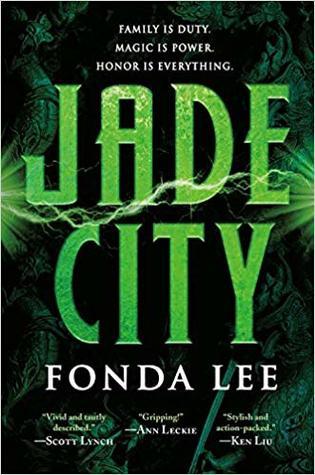
Jade City by Fonda Lee
On the island of Kekon, jade grants those with the ability to wield it special powers, but promises pain and death for anyone lacking the right genetics who tries to use it. As a result, jade smuggling is a profitable business and those families with the capacity to use the mineral, called Jade Bones, make up the highest class of society. But now ordinary citizens are somehow gaining the ability to use jade, and it is throwing the society of Kekon into turmoil. As suspicion fuels inter-clan warfare among the noble class, the future of the island nation hangs in the balance. In the midst of this chaos stands three siblings. Kaul Lan, the new, young, peace-loving leader of his family, finds himself faced with the uncomfortable necessity of bloodshed as he tries to steer his clan through these uncertain times. Lan’s brother, the hot-tempered and passionate Kaul Hilo, is like a warrior straight out of old tales: honorable, protective, and hungry for battle and glory. Their sister, Shae, is an independent modern woman who chose to cast aside her jade along with her traditional roles in favor of freedom and marriage to an outsider. Added to this cast of characters is Wen, Hilo’s forbidden lover, who is burdened by the combination of coming from a disgraced family and being a rare Stone Eye, a supposedly cursed person completely immune to jade. All four have their differences and disagreements, and the tension between them mirrors the growing strain in their homeland at large. It will take them all, however, to find out who is responsible for the dangerous drug allowing non-Jade Bones to wield the sacred stone before it is too late.
This is a novel that bridges high fantasy and urban fantasy, weaving a tale of heroism, betrayal, and intrigue against the backdrop of a thoroughly modernized enchanted society. Lee’s narrative is intricate and interesting, her world building is exceptional, and her magical system is comprehensive and intelligent. Running throughout the entire tale are elements of Chinese myth and culture, with folklore concerning gods and monsters playing a vital part. Complex, well-written, and engaging, Jade City is grand and unique fantasy adventure.
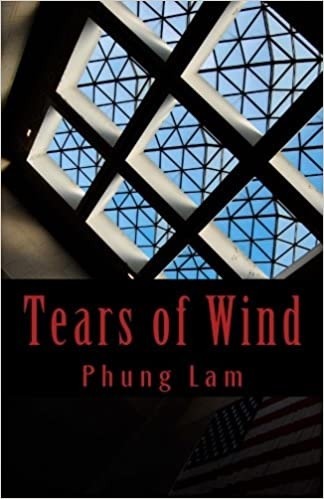
Tears of the Wind by Phung Lam
This collection of short stories is a touching as it is magical. Taking place on the fictional Island of Wishes, each tale explores human nature and the deepest desires people harbor in dark corners of their minds. From a lonely heart seeking solace to a soul hungry with ambition, this anthology explores the not only the power of wishes, but the question: what would people do if the one thing they truly wanted most could be theirs? It’s basically impossible to find an English version of this book, and I had to rely on the Smart Book translation application for the ebook format. That led to some odd phrasing in portions of the text, but the collection was nonetheless enjoyable. That is because Lam writes not only with imagination but also with a keen understanding of humanity.
The narratives are dreamlike, the content somewhat akin to magical realism and the tone ultimately surrealistic. Ranging from heartrending to horrifying, Lam weaves stories about the darkest parts of ourselves, when we harbor wishes we dare not name, as well as about the unforeseen and often terrible consequences of getting exactly what we think we want. The author explores the nature of love, the power of longing, and the baser side of our very nature. It’s an engaging collection that seems, and its core, to turn upon one basic thought: be careful what you wish for.
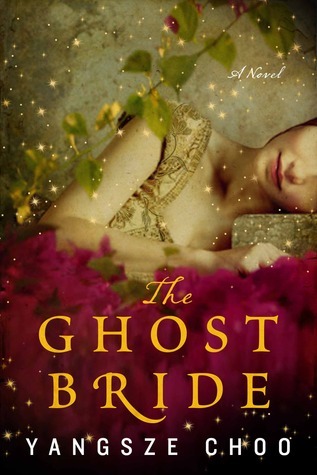
The Ghost Bride by Yangsze Choo
Set in late-nineteenth-century Malaya, on the island of Borneo, this novel sparkles with folk beliefs and superstitions. Li Lan is a spirited girl and only child from a family wrapped in what can only be called genteel poverty. Her life is certainly not perfect—her mother is dead, her father, although loving, has allowed his grief to lead to opium addiction, and her marriage prospects are extremely limited—but things aren’t so very bad. Apart from occasional longings for beautiful new clothing such as she sees other wealthier girls sporting, Li Lan would be reasonably content if it weren’t for one thing: her father has asked her if she would like become a ghost bride. He says it almost as a joke, but the moment he speaks the words, the wheels of fate start to turn. The rare tradition of ghost brides is meant to mollify the spirits of wealthy young men who died without marrying, and it presents both tempting and terrifying prospects. While accepting would mean financial help for her aging father as well as a place for Li Lan herself in one of Malacca city’s most affluent households, it would also mean giving up any dreams of love, passion, or children of her own.
Li Lan, of course, refuses, especially when she starts to develop feelings for another decided living man. But the choice may not be as easy as the thinks. She finds herself haunted by Lim Tiang Ching, her spectral suitor, and he is determined to have her. Tiang Ching, the young woman soon learns, was selfish and cruel when he was alive, and death hasn’t improved him. Desperate, Li Lan seeks the help of a local wise woman, and unwittingly finds herself embroiled in a supernatural struggle where ghosts are all too real and her only hope hangs on a mysterious young man who may be more than he seems, and who is most definitely keeping secrets. On top of that, she begins to realize that the Lim family is harboring some dark secrets of their own, and one of them may be deadly.
Choo’s narrative is imaginative as well as brimming with cultural folklore and traditions. A blend of mystery and fantasy, it is engaging from start to finish. Many of the characters are interesting and a little quirky, although a couple feel less well developed and there were a few moments when I felt the protagonist was a bit too flighty for my tastes. Nonetheless, this is a fun, entertaining fantasy book, perfect for an evening of light reading with a cup of tea or coffee at your side.
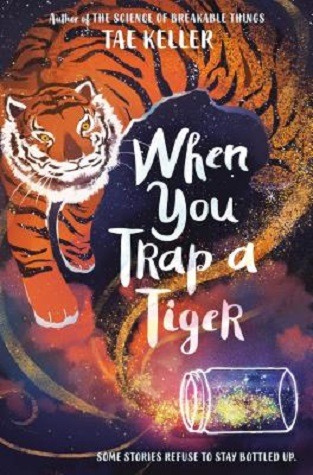
When You Trap a Tiger by Tae Keller
This is a truly wonderful novel blending together magical realism, mythology, family drama, and a deeply touching coming of age tale. It’s a beautifully written and imaginative narrative where opposites don’t so much collide as they do interweave in a complex dance. Dreams tangle with reality, childhood blurs with adolescence, Korean tradition intersects with modern America, folklore mingles with daily life, and stories become solid enough to touch. Through it all runs a profound understanding of emotion and the human spirit.
Lily has always loved visiting her Korean grandmother, catching stars to learn what stories they hold and listening to traditional tales from their ancestral homeland. This, however, is different. Now Lily, along with her mother and her sister, are moving in with the old woman because Lily’s grandmother is sick, and isn’t getting any better. A new city, a new school, and new fears about her beloved relative would all be difficult enough, but Lily has another problem: upon arriving, she sees a tiger straight out of one of her grandmother’s tales. This is both a metaphor for many things: words unsaid, terminal illness, fear, and long-ago mistakes. It is, however, also an introduction of the magical real. Upon informing her grandmother about the big cat, Lily begins unraveling the old woman’s greatest tale yet, and takes the first step in a personal journey to discover family secrets and leave her childhood behind. As marvelous as it is heartfelt, When You Trap a Tiger addresses conflicts between generations and cultures, as well as the reconciliation of the past, through the lens myths and storytelling. At its core, this is a novel about the power of both love and stories, as well as about one girl finding herself.
Perhaps one of these books will make an excellent companion over the next several days as celebrations of the Lunar New Year progress. Blending Asian folklore with a sense of the fantastic, these works may prove to be the perfect way for those not immersed in these festivities to still capture a bit of the season’s spirit. Readers hungry for an interesting narrative that is a little out of the ordinary will likely find any one of these to be a feast for the imagination, as well as a wonderful way to start of the Year of the Ox. Happy Reading!
#book#books#novel#novels#short stories#collection#review#reviews#book reviews#book review#book recommendations#recommendation#recommendations#Lunar New Year#Chinese New Year#fiction#fantasy#magical realism#Asian#folklore#mythology#myth#culture#folktales#reading#read#reader#book lover
9 notes
·
View notes
Text
9 Different New Years in India: Celebration of Culture and Harvest!
This year has come to an end, and we all are ready to welcome 2020. We all preparing for New Year's Eve party and some of us have already started listing down all the new year resolutions for 2020. But did you know that this is not the only new year celebrated in India?
Thanks to the cultural diversity of India, the masses of the country celebrates the New Year followed by both solar and lunar calendar system. Hindu calendar, which is based on the movement of the moon, has the maximum number of new years while the other religious new years are like Islamic New year!
Every region has a unique culture and traditions of celebrating the New Year. Majorly New Year is celebrated at the time of harvesting of crops. Today, we are listing the major New Year celebrations from different parts of the country.
This post contains links. Thank you so much for your support and for helping keep this blog running!
1. Baisakhi - Punjab
Baisakhi is the biggest harvest festival celebrated across entire North India. Baisakhi holds a special place in the land of Five rivers, Punjab. Commemorating the first day of the Vaisakh month, the Sikh community of Punjab also celebrates this day as the formation of the Sikh Khalsa. It is celebrated mainly at the birthplace of the Khalsa and the Golden Temple in Amritsar.
Read more: https://cupdf.com/document/new-year-india.html
2. Jude Sheetal - Bihar, Jharkhand
Also known as Maithili New Year, it is celebrated by the Maithilis in Bihar, Jharkhand and even Nepal. Maithili New Year is usually celebrated on the 14th of April according to the Gregorian calendar.
Read more: https://cupdf.com/document/new-year-india.html
3. Bohag Bihu - North Eastern States
Also known as Rangali Bihu, Bohag Bihu also falls on the day of Baisakhi and Puthandu in Assam. Celebrating the new harvest with lots of sweets, shared among the family and friends with the exchange of more gifts. Bohag Bihu is celebrated for three days straight with many different traditions. Bihu dance is a form of celebration for the people
Read more: https://cupdf.com/document/new-year-india.html
4. Gudi Padwa - Maharashtra
Gudi Padwa is the first day of Chaitra month and marked as the New year in Maharashtra. A 'Gudi', a beautiful arrangement of silk saree or cloth tied to stick with a 'Lota' on the top and then decorated with sweets and garlands made of neem and mango. The day symbolises the victory of Chatrapati Shivaji Maharaj over his enemies and Shalivahan’s victory over the Sakas.
5. Ugadi - Karnataka, Telangana and Andhra Pradesh
Ugadi or Yugadi is the New Year celebration of Andhra Pradesh, Telangana and Karnataka. It is observed in these regions on the first day of the Hindu lunisolar calendar month of Chaitra. Traditional sweets and 'Pachadi' (sweet syrup) – made with raw mangoes and neem leaves – are served with the Ugadi meal. Ugadi is the festival of new beginnings, so people buy new clothes and eat lots of good food with friends and family.
Read more: https://cupdf.com/document/new-year-india.html
6. Jamshedi Navroz
Novruz is the Iranian New Year, celebrated by many ethnolinguistic groups all over the world. In India, on the next day of Pateti, Parsis celebrate Navroz.
7. Vishu - Kerala
Vishu festival marks the beginning of harvest in the bountiful land of Kerala. It is a festival full of lights and fireworks. The day starts with an arranging harvest's fruits, vegetables and seasonal flowers in front of a mirror. This arrangement is called the Vishu Kani. On this day, devotees also visit Sabarimala Ayyappan Temple and Guruvayur Krishna temple for prayers.
Read more: https://cupdf.com/document/new-year-india.html
8. Pohela Boishakh - West Bengal
Another state that celebrates a different New Year is West Bengal. The Poila or Pohela Boishakh is the first day of the Vaisakh, which is the Bengali New Year. You will witness cultural celebrations all over the state, with Bengalis going on a crazy shopping spree and musical shows. Santiniketan is well known for its Noboborsho (New Year) festivals.
Read more: https://cupdf.com/document/new-year-india.html
9. Islamic New Year
The Islamic New Year starts on the first day of Muharram, which is the first month of the lunar Hijri calendar that is followed by Islam. The day also marks the migration of Prophet Muhammad from Mecca to Medina in 622 AD, and the journey was called Hijrah or Hijri, and hence the name 'Hijri calendar'. The New Year is celebrated with sharing meals and prayers with the family.
Read more: https://cupdf.com/document/new-year-india.html
0 notes
Text
Week 1: Project mātauranga notes and reflection
Māori astronomy is neglected within western views and astronomy because western society only embodies logic and science. However, Māori choose to incorporate spirituality alongside logic and general science and maths they had formed over countless generations by observing the stars.
Māori astronomers have come together to look back at how their ancestors navigated throughout the seas, how they kept in check with what day, month, season it was throughout the year; the main goal is cultural preservation and revitalising. Māori were excellent mathematicians and scientists without Western technology and knowledge. Tatai arorangi was an astronomical knowledge system that affected how Māoriread the stars and calculated basic mathematical principles to form knowledge about the world. Much of this has been lost, which is why S.M.A.R.T (Society of Māori, astronomy, research and tradition) was formed, as western astronomy, science, math, and the general public have a lot to learn from Māori. The purpose is to collect, analyse and share all the surviving knowledge of tatai arorangi.
Māori explanation of the big bang and creation of everything:
In the beginning, there was Te Kore (the nothingness) arose from Te Kore came Te Po (The nights), and there were many nights of darkness and movement of shadows. From this period came the formation of Ranginui (Sky Father) and Papatuanuku (Earth Mother). Both lay tightly together, crunched together with no light. Between them were their six children, who had enough of the darkness and tight space. It was not until Tane, one of the children who separated his parents, pushing Ranginui up in the sky and kept Papatuanuku grounded. Te Ao Marama (light and life) followed after, as Tane hung Whanau Marama (family of light), which included Te Ra (Sun), Te Marama (Moon), Ngā Whetū and Hīnātore.
This is not too dissimilar to western astronomy's theory of the big bang. In the beginning, there was nothingness except for a hot, condensed form of matter which then exploded outwards, creating the universe.
‘The Māori knowledge framework was based around whakapapa korero, which were narratives that held philosophical and technical information. When Europeans analysed a lot of that korero, many of it was reframed into historical and linear types of analysis. A lot of those narratives got broken down and defined as myth or history’ (Tātai arorangi 5:58).
Europeans try to break down past events within their western logical framework, placing past events into two boxes of history or myth. If it does not fit the historical framework, it gets dubbed as myth, as they did with Māori History; it did not make logical sense. ‘Knowledge of tatai arorangi was largely lost or dismissed following colonisation of Aotearoa’ (Tātai arorangi 7:09). Tatai arorangi was very important for the survival of Māori; it helped Māori with cosmology, how and when they should plant, how to tell time and how the orientation of buildings and what should be built in conjunction with the stars.
Māori used specific stars in the sky to denote the time and season the earth was in, explicitly taking a mental note of what star rose first in the morning before the sun. The lunar calendar was an essential system for Māori, noting the moon’s phases to what event should be undertaken that day, e.g. if it was a full moon, it was the best garden today but not to fish. Various tribes and regions had different things that they could do that day, depending on the phase of the moon. Māori soon realised that some months had 32 days and some had 28 days, and soon this came out of sync, so to reset the calendar, they used the rising of Matariki (Pleiades star cluster).
Māori mapped the stars across the horizon, mentally taking note of which star constellation rose in the morning in a particular direction and which star constellation set at night in a particular direction. This created a star compass with waka in the middle and the horizon divided into 32 equal-sized houses.
Works Cited:
"Tātai arorangi". Project Mātauranga. Presented by Ocean Mercier (Ngāti Porou), season 2 episode 8, Pokapū Akoranga Pūtaiao: Science Learning Hub, 2012, https://www.sciencelearn.org.nz/resources/1274-revitalising-maori-astronomy.
0 notes
Text
2021 Feng Shui Planner and Calendar - Year of the Ox
This is a PDF digital download of our latest book, 2021 Feng Shui Planner and Calendar — Year of the Ox.
The first part of the book includes the overview of the 2021 year of the Ox, The Flying Star analysis, Feng Shui afflictions, and the 12 zodiac signs.
The second part includes the monthly and weekly calendar, 24 solar terms, the auspicious directions, conflicting animal sign of the day, favorable/unfavorable activities, and so on. You can select an auspicious date for planning an important event, travel, placing a Feng Shui cure, and so on.
The third part has more planning and brainstorming pages for you to write down ideas and goals.
We try to follow the traditional lunar Feng Shui calendar to provide a reliable reference.
The 2021 Feng Shui Planner and Calendar include both A4 and US letter size PDF files. The cover is in a separate JPG file. The book has 219 pages in total. You can print out any pages you need or leave the book on your computer for reference.
You will receive a Zip file that contains 4 documents:
1 letter size cover in JPG and PDF
1 letter size PDF file for the book
1 A4 size cover in JPG and PDF
1 A4 size PDF file for the book
This book will also be available on Amazon as a paperback printed version soon. Check out Amazon soon if you prefer a paperback book.
Once you purchase the PDF book, the download link for this e-book will be active for 24 hours after your first download.
Happy 2021!
This is a PDF digital download of our latest book, 2021 Feng Shui Planner and Calendar — Year of the Ox.
The first part of the book includes the overview of the 2021 year of the Ox, The Flying Star analysis, Feng Shui afflictions, and the 12 zodiac signs.
The second part includes the monthly and weekly calendar, 24 solar terms, the auspicious directions, conflicting animal sign of the day, favorable/unfavorable activities, and so on. You can select an auspicious date for planning an important event, travel, placing a Feng Shui cure, and so on.
The third part has more planning and brainstorming pages for you to write down ideas and goals.
We try to follow the traditional lunar Feng Shui calendar to provide a reliable reference.
The 2021 Feng Shui Planner and Calendar include both A4 and US letter size PDF files. The cover is in a separate JPG file. The book has 219 pages in total. You can print out any pages you need or leave the book on your computer for reference.
The monthly and weekly spread has 2 pages. The left page is on the even page number and the right page is the odd number. If you are going to print out and bind into a book, remember the even number will be on the left side when you open the book so the format stays correct.
You will receive a Zip file that contains 4 documents:
1 letter size cover in JPG and PDF
1 letter size PDF file for the book
1 A4 size cover in JPG and PDF
1 A4 size PDF file for the book
This book will also be available on Amazon as a paperback printed version soon. Check out Amazon if you prefer a paperback book.
Once you purchase the PDF book, the download link for this e-book will be active for 24 hours after your first download.
Any questions, please email [email protected]
Happy 2021!
#feng shui calendar#feng shui planner 2021#2021 year of the ox planner#2021 feng shui calendar#flying star feng shui 2021#pdf ebook 2021 feng shui planner#pdf ebook download for 2021 ox year feng shui planner#lunar calendar 2021
0 notes
Text
Worldbuilding: Calendars
When I first started writing The Forgotten Hollows of Jordaré I hit a problem that I absolutely did not want to deal with: Dates. [warning! Howto Mathematics included!]
Dates and time systems are an icky thing for most writers whether you are writing in a modern or historical time, or even a purely made up one like my own. - Use a modern system like the Georgian, or even cultural such as Chinese or Hindu, then you lock yourself into a few situations (historical events clashing, becoming outdated [i.e. “Today - 1980″], and sometimes it pollutes your fictional world with the reality with such a simple connection.) - But making one up invokes a whole load of extra work for you, and if not done right you are going to confuse readers and yourself nine out of ten time. Even if you do a cop-out where you simply change every month/day name to some new random term, you either go back to confusing your readers or it just become obvious you ripped off good old George! It’s just easier to not bother.
I wanted to avoid dates so much that I even went as far as to write in story: “Cole was becoming rather annoyed as the people of this area did not seem to bother keeping track of dates, only the week days.” A+ for avoidance!
But you know what? I still couldn’t get away from it. The story took a turn that I didn’t really think ahead on, Cole was hunting down a beast and acting like a detective in trying to figure out its habits, and so I made myself a private calendar with loose dates just to keep track of my own events. And you know what? I still confused the hell out of myself. Calendars are horrible!
But they are also a fantastic thing and one of the marvels that make just one of the attributes of any civilization, ancient or modern. And one day recently I came across a three part video series by Artifexian on calendars for a fictional setting [Soli, Lunar, Lunisolar] With my mind blown and my creative juices flowing, I decided to just dive right in into making up my own system and lore behind it!
Not to discredit his spreadsheet he provides and uses, it gave me some ideas, but it actually didn’t really help me in making things clear. Sure, I figured out that I wanted to do a random number of 381.2 solar days in a years time, and that I ended up making a random-ass number of 11.4529(goesonforever) lunar cycles per year; and that I wanted to do about 11 months in the year with a rather boring structure of 35 day months(5 7-day weeks) except for the last month which was 31-32. But that still didn’t help me with one thing: Calendars are used to keep track of important events.
So here comes the adventure and the how I did it for you to make use of if you so chose.

I have a solid structure that avoids the Gerogian complication where one year January 1st falls on a Sunday, while the next year it could be Monday, all funky days happen in the month of winter, which for my primary culture is counted as not a month but a time of mourning, and from winter solstice it is then counted down to the start of the new year. Only complicated thing to mentally note is that every 5th year it is a leap year and so there will be 32 days during winter. (I have yet to devise month names and such)
That is a compact version above will help a lot in over all my story at a glance, but that wasn’t enough for me because my cultures follows the moon phases and I needed to know when those happened and at any given year without need of counting forwards or back. I wanted the program to do the hardwork for me. So, onward to the convoluted mess of logic and if statements! Took me 3 whole days of headaches but I managed to figure out a way that gave me the lunar cycles of the year with a 94% accuracy, which is good enough for me at this point. And if you wish to do the same for your own world, keep reading as to how I did it and the math logics devised. (and keep in mind, I’m not a math major so if you are smarter than me and know how to make a cleaner system, kudos to you please teach me, sempi!)

I started with inputting my data. B2 How long my solar trip around the sun was to be in days, B3 how long my lunar cycle would be in days (the time it takes to make one full pass from full moon to new moon back to full moon), B3 I then divided the my year by my lunar cycle to get my cycles per year. Because I have a .2 in my solar year length, this means each 5th year would be a leap year, so B4 was just a flat number. B7 was [=B1/B6], and B8 just worked out the Solstice cycle with [=B1/4] (4seasons.) D1 was [=1/B1] to get the fraction amount of what a passing day equaled as part of the year, and D2 was [=1/B2] for the same reason, what a passing day equaled to the total cycle.
With these numbers in place, if I so chose to change my year length and/or my lunar cycle duration, it will automatically change ALL the information accordingly and should still be accurate.

Now for the complicated portions. For this reason, I am going to link you to the .ods file I created to see for yourself and tinker, and get a better look at the math as I’m sure all I’m going to say won’t make as much sense.
H2 [=B1*H1] - if it is year 1, there then will be 381.2 days passed at end of year since calendar start. If it is year 0009, 3430.8 days will pass.
I4 [=B1*(H1-)] - same as H2 but minus 381.2.
M6 [=I4/B2] - this gave the total of lunar cycles that completed. year 1, none, year 9 a total of lunar 91.623 cycles had passed.
M7 [=ROUNDDOWN(M6)] - strips the decimal value.
M8 [=M6-M7] - captures the decimal value
N7 [=B2*M7] - how many rounded days used in past lunar cycles.
N8 [=B2*M8] - same as above but just with the decimal value which will be the days remaining until the next full moon.
Now... this will give me the means to get an output that will tell me the month/day dates for the inputted year of when the full moon will be.

redundantly: R1 [=-N8] and S1 [=R1]
S2 through S13 is a series of [=S1=B2] upstepping where it takes the previous total and adds the next lunar cycle.
T2 through T13 is a series of this [=ROUNDUP(ROUNDDOWN(S2)/35)] to give me the current month of the year.
U2 through U13 is a series of this [=ROUNDDOWN(S2-((T2-1)*35))] to give me the current day of that month that the full moon falls on.
V2 through V13 is only a round down statement for each number in the relative S column and went unused in the finished product.
How does ALL of the above work? All that leads up to N8 as the star of the show. By taking the decimal value (ie the left over days of the year that have not completed a lunar cycle) from the previous calculations and multiplied into actual days, this number of days subtracts from the start date of the new year, and thus offsets the calculations in the R1 thru V13 grid. In year 8 there was a total of 20.75 days remaining in the year after the last full moon, so by subtracting 20.75 from our normal 33.284 lunar days, we end up with 12 days into the new year being the full moon.
WOOF!
For most people, that may be all you need because your actual calendar could be drawn out remain the same as dates do not change, you would just put notations down in pencil for the important changing dates such as the moon cycles and any cultural festivals revolving around lunar cycles.
For me, to have a visual representation of what I am use to with the Georgian calendar, I went one step further and started taking my final lunar date grid and having it read by the year calendar via a series of Conditional Formats.

I am not going to get into conditional formats today as that isn’t nearly as important as everything else I covered and there is other people out there that explain their use.
I do hope you found that both interesting and helpful and hopefully not more confusing than it needed to be, and if you use this knowledge to craft your own calendar for your fictional world, I would LOVE to hear about it :D Take care, happy worldbuilding!
2 notes
·
View notes
Photo

Egyptian Religious Calendar
Today 21 August 2017 - I day of Tekhy, the first month of the Lunar Calendar (in the CDXVIII Great Year of Ra according to the Civil Calendar). Beginning of the New Year according to the Lunar Calendar: the New Moon of today opens the New Year of the Egyptian Lunar Calendar, as the first New Moon after the Heliacal Rising of Sothis (that occurs on 19 July of the Julian Calendar corresponding to 1 August 2017 of the modern Gregorian Calendar) marks the first lunar month of the Lunar Year. Best wishes to all in this highly sacred day, may the Gods give to us all what is truly good and avert all that is adverse in this New Year!!! (For more informations, see our book “Egyptian Religious Calendar: CDXVII-CDXVIII Great Year of Ra (2017CE)”, where you will find the full version of the Egyptian Calendar with the complete translation of the Temples’ calendars. The book is available both in paperback format and as a digital ebook:http://a.co/8oFE52w ) Religious Prescriptions: Favorable day “Make a holiday on this day. Offer to the Followers of Ra on this day (...).” [c.c.] Religious Festivities: The I day of the lunar month is sacred to Montu-Ra-Harakhty. It is the “Feast of Psedje(n)tyu/Feast of the New Moon” and Thoth is the God of the Feast. - “Feast of Osiris.” [c.c.] - “Feast of Osiris.” [Ramses II, Abydos] - Feast of Shu and Tefnut (five-day festivity, IV day of the procession) [T. Behdet, c. Hathor] - “Feast of the Appearing of Min.” (every New Moon day) [T. Ombos, west side] - “Performing 'the Triumph of Thoth' in the presence of Ra.” [T. Iunyt] Temple of the Goddess Hathor at Nitentóre (Dendera), detail from the ceiling of the Outer Hypostyle Hall: the God Thoth (ibis-headed, blue-skinned, wearing the 'Atef'-Crown with two feathers and ram's horns) making adorations to the 'Udjat'-Eye represented inside the Full Moon disk supported by the Crescent Moon
72 notes
·
View notes
Text
Time symbolism
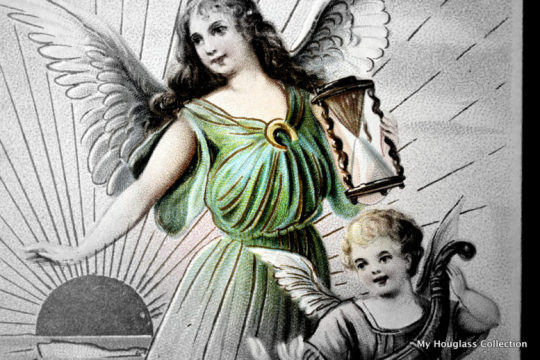
Time symbolism
What is the symbol of time? Symbol of Time is The Hourglass Symbol of Time, Personification of Time - Father Time Time symbolism - What is the symbol of time? My Hourglass Collection - Time and Hourglass History and Symbolism. Welcome to MHC Virtual Museum! See also Time synonyms, Time Philosophy and The Full History of Time

Marilyn Monroe Hourglass Figure paper-time
Any Research is Symbolism
Time Symbolism, or time semiotics��as it’s known in technical circles, plays such a large part in human communication because people are constantly looking for deeper meaning. Whether it’s in the stars, drawn on a cave wall or in the newest visual content, we add such meaning to our communication through the use and interpretation of signs. The multiplication sign, also known as the times sign or the dimension sign, is the symbol X The multiplication sign (×), often attributed to William Oughtred (who first used it in an appendix to the 1618 edition of John Napier's Mirifici Logarithmorum Canonis Descriptio), apparently had been in occasional use since the mid 16th century SYMBOLIC TIME is understood to be the temporal form that organizes the symbols of a religious system into an order of periodicity. The analysis of symbolic time extends the understanding of religion as a symbolic system, so that the major functions of time within the system may be taken into account: the time intrinsic to the formation of religious symbols and to the ritual performance (i.e., the time that is internal to the sacred event)the connection that symbolic time has with the history and dynamic of a religious social bond, andthe time that is specific to the intentional life of the individual. Intentional Character of Symbolic Time Symbolic periodicity encompasses, in its temporal structure, both change and duration, implying a sheer sequence of symbolic events and also a type of internal correlation of events and symbols that reflects the functional unity of the interval of time and the continuity of its structure.
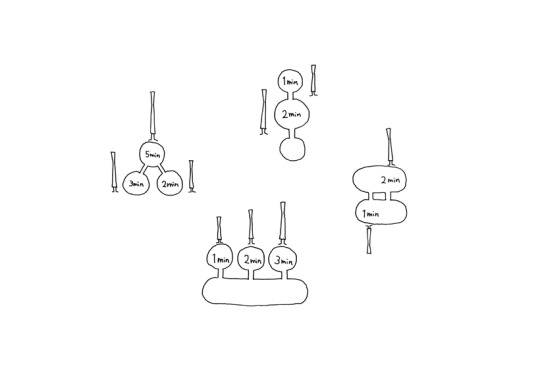
variations of time
Time symbolism
Time in physics. Time symbol science. From: Time in physics and time Science? Time in physics is defined by its measurement: time is what a clock reads. In classical, non-relativistic physics it is a scalar quantity and, like length, mass, and charge, is usually described as a fundamental quantity. Time can be combined mathematically with other physical quantities to derive other concepts such as motion, kinetic energy and time-dependent fields. Time constant In physics and engineering, the time constant, usually denoted by the Greek letter τ (tau), is the parameter characterizing the response to a step input of a first-order, linear time-invariant (LTI) system. The time constant is the main characteristic unit of a first-order LTI system. Physically, the time constant represents the elapsed time required for the system response to decay to zero if the system had continued to decay at the initial rate, because of the progressive change in the rate of decay the response will have actually decreased in value to in this time (say from a step decrease). In an increasing system, the time constant is the time for the system's step response to reach of its final (asymptotic) value(say from a step increase). In radioactive decay the time constant is called the decay constant (λ), and it represents both the mean lifetime of a decaying system (such as an atom) before it decays, or the time it takes for all but 36.8% of the atoms to decay. For this reason, the time constant is longer than the half-life, which is the time for only 50% of the atoms to decay. More about Time constant on Wiki. See also: Time in physics and time Science? MHC YouTube channel Symbolism of Melencolia I by Albrecht Dürer Create Ma, Upgrade Ma A New Theory On Time Frank LaCavera hourglass collections Time perception or sense of time Time and Text Lunar calendar and moon’s phases now Time Travel Timekeeping is a complex of technological and scientific issues, and part of the foundation of recordkeeping. In addition to time-related themes, the hourglass is synonymous with cycles and balance Energy passes between the two sides of the hourglass just as the energies of our world are contained by the atmosphere and crust. All of the natural processes and cycles occur there (not including what happens in space, of course), which gives us a greater sense of relation with our environment. This also forces us to realize our roles in the natural cycles happening around us. Hourglass symbolism Time symbolism Ancient alchemists recognized the concept of balance in the hourglass. Its very shape is made up of triangles balancing each other out. Alchemists interpreted these triangles as representing two aspects of nature: the upper being the sky and the lower equating with Earth.
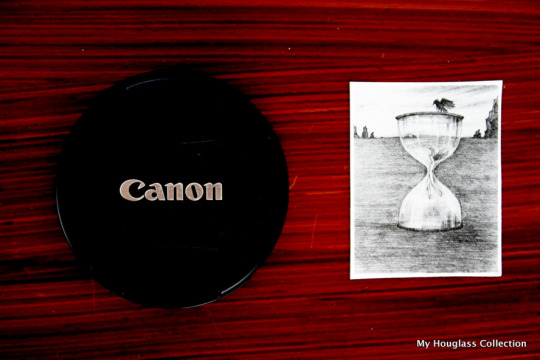
Hourglass 304, Magic Card
The meanings of symbols
The symbols carved in stone provide some of the best examples of folk art in Dumfries and Galloway. Richly decorated stones are often very attractive and combine emblems with different meanings. The first being symbols that represent mortality / immortality / biblical references, the second type representing the occupation and status of the people commemorated. Many headstones include a collection of emblems which may vary in style and sophistication even within the same churchyard. What is the symbol for time? More about Symbolism of Melencolia I by Albrecht Dürer SI Units The international system (SI) of units, prefixes, and symbols should be used for all physical quantities except that certain special units, which are specified later, may be used in astronomy, without risk of confusion or ambiguity, in order to provide a better representation of the phenomena concerned. SI units are now used to a varying extent in all countries and disciplines, and this system is taught in almost all schools, colleges and universities. The units of the centimetre-gram-second (CGS) system and other non-SI units, which will be unfamiliar to most young scientists, should not be used even though they may be considered to have some advantages over SI units by some astronomers. General information about SI units can be found in the publications of national standards organisations and in many textbooks and handbooks. time - second
TIME SYMBOLISM

Symbols of Time Symbolic Representation of time
Date and time symbols
Date and time symbols are divided into locales, each of which is detailed in the following sections. Locale Group A Locales: af-za, en, en-au, en-be, en-bw, en-ca, en-gb, en-hk, en-ie, en-in, en-mt, en-nz, en-ph, en-sg, en-us, en-vi, en-za, fo-fo, gl-es, id, id-id, is, is-is, it, it-ch, it-it, kk-kz, ms, ms-bn, ms-my, nb-no, nl, nl-be, nl-nl, no, no-no, om-et, om-so, pl, pl-pl, pt, pt-br, pt-pt, so-dj, so-et, so-ke, so-so, sv, sv-fi, sv-se, sw-ke, sw-tz Locale Group B Locales: be-by, bg-bg, el, el-gr, fi, fi-fi, hr, hr-hr, hu, hu-hu, ja, ja-jp, ko, ko-kr, ro, ro-ro, ru, ru-ua, ru-ru, sh-yu, sk, sk-sk, sl-si, sq-al, sr-sp, th, tr, tr-tr, uk-ua, zh, zh-cn, zh-hk, zh-mo, zh-sg, zh-tw More on IBM website
Father Time Exhibition
Personification of Time Dynamic Vision Board Meta Model by Adam Pierce MHC virtual museum FATHER TIME, father time symbol, father time images, old father time, father time is grim reaper, father time mother nature, father time statue, father time vintage, baby new year
"Copy and Paste" Time Symbols

"Copy and Paste" Time Symbols Time symbol is a copy and paste text symbol that can be used in any desktop, web, or mobile applications. Every time symbol: ⌛ Hourglass done Symbol ⏳ Hourglass not done Symbol ⌚ Watch Symbol ⏰ alarm clock Symbol 🕛 twelve o’clock Symbol 🕚 eleven o’clock Symbol HTML Hex ⌛ Day & Night Symbols Through the ages, celestial happenings and natural phenomenon have been used to symbolize important thoughts and concepts. The cyclical occurrence of day and night was one of the things occurring in nature that was believed to hold specific meaning. While different civilizations had different day & night symbols to record the passage of time, Day and Night, by themselves, were thought to have strong symbolic meanings. The recurring phenomenon of day and night was always considered very meaningful as it was believed that the survival of human species depended majorly on synchronizing the bodily and mental functions with the peculiar demands of day & night. The Day and the Night seem to present two entirely different worlds. Day and night changes even seem to have biological effects on mankind. The creatures that are aggressive, alert and seeking in the day become quiet and inactive at night. The dramatic contrast presented by Day and Night is equated with the disparity between life and death, light and darkness, consciousness and unconsciousness. Day and Night symbolize, respectively, the birth of the Sun and its death. With the rising Sun, the Day is considered representative of new life, and fresh beginnings, possibilities, hopes, and opportunities. It also symbolizes the active, masculine principle and the rise of consciousness. A lunar calendar is a calendar based upon the monthly cycles of the Moon’s phases (synodic months), in contrast to solar calendars, whose annual cycles are based only directly upon the solar year. Lunar calendar and Moon’s phases Lunar calendar, any dating system based on a year consisting of synodic months The Sumerians were probably the first to develop a calendar based entirely on the recurrence of lunar phases. Each Sumero-Babylonian month began on the first day of visibility of the new Moon.

Symbol of Time and Life - Death of Time
Time symbolism
Symbols of Life Ankh has a cross shape but with an oval loop in place of an upper bar. The origins of the symbol are not known, although many hypotheses have been proposed. It was used in writing as a triliteral sign, representing a sequence of three consonants, Ꜥ-n-ḫ. This sequence was found in several Egyptian words, including the words meaning "mirror", "floral bouquet", and "life". In art the symbol often appeared as a physical object representing either life or substances such as air or water that are related to it. It was especially commonly held in the hands of deities, or being given by them to the pharaoh, to represent their power to sustain life and to revive human souls in the afterlife. One of the most common decorative motifs in ancient Egypt and was adopted by neighbouring cultures as an artistic motif. Since the late 20th century, in the Western world, the symbol has come to be used decoratively, as a symbol of African cultural identity, Neopagan belief systems, and the Goth subculture. Symbol of Time - The Hourglass
Time is Life and Death
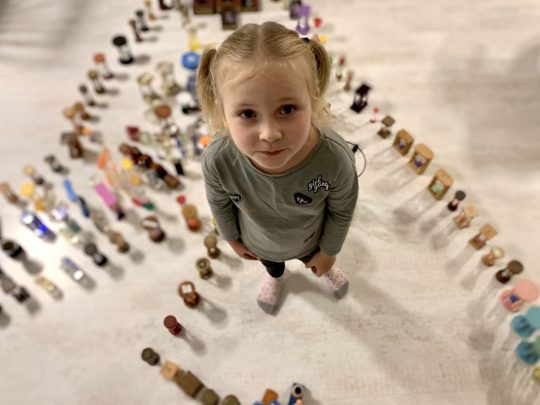
What is it Time of Life? The ankh is an ancient Egyptian hieroglyphic symbol that was most commonly used in writing and in art to represent the word for "life" and a symbol of Life. Its use continued through the Coptic Egyptians who adapted it as the crux ansata, a variant form of the Christian cross. Symbols of Death Symbols of Death and Time (Western) Medieval and Renaissance art made use of a number of emblems to symbolize death and mortality. Although a central theme of Christianity for hundreds of years the was triumph over death, the onset of the black plague altered public perception, and the emphasis was placed on the triumph of death over life and the necessity of repentance.
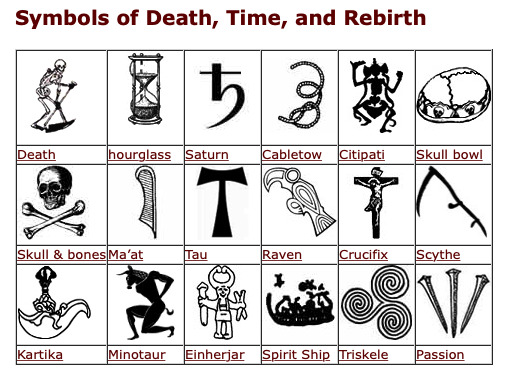
Symbols of Death, Time and Rebirth Symbols of resurrection common in Christian art became less popular as reminders of the impermanence of life and the punishments of hell became ubiquitous. The most common symbols of mortality were the grim reaper and his scythe, the death’s head, and the hourglass, all appropriated from icons of Greek and Roman Paganism. Slogans such as “remember death” and “all is vanity” were omnipresent- death was around the corner, and one had better repent if one was to avoid an eternity of damnation. The source of these macabre symbols was, ironically, the paganism that Christianity had supposedly replaced. In ancient times, the emblem of the God Saturn (Chronos to the Greeks) was the scythe, which represented the nature of the cycles of time. The scythe symbolized not only impermanence (all things living will be cut down), but the nature of the life cycle- plants must die to feed animals, and the tool of the harvest is depicts the necessity of death for the renewal of life. Thus, death was depicted as a natural part of the passage of time. The image of Chronos devouring his children seems macabre, but illustrates that the the Greeks believed the passage of time is so inevitable that even the gods were consumed by it.

Hourglass = Rebel for Life! The hourglass is another emblem of time (see Hourglass Symbolism), although hidden within is the promise of life- because the hourglass is reversible, it held within a promise of resurrection, a symbolism not lost on everyone- all of these emblems later became symbols of resurrection to Freemasons and Rosicrucians who grasped their true ancient meanings. The skull was a frequent companion to ascetic desert saints in numerous Christian artworks, and was often paired with the book, a symbol of studiousness. In this manifestation, the death’s head was less ominous, and symbolized the rejection of the impermanent material world for the life of the spirit. Mary Magdalene is probably the best known example of these two emblems in art. *Some scholars theorize that the appropriation of ancient symbolism was a subconscious (or even deliberate) attempt to appease the old gods. In later times, death was depicted as a process of the alchemical arts. Common alchemical emblems included the crow, the skull, and the tomb as symbols of the necessary death of the ego/personality. Emblems of death are also prevalent in Masonic art and symbolism. Contemplation of mortality is a frequent theme in Masonic ritual and practice (see Masonic Hourglass)
Time symbolism
Día de los Muertos The Day of the Dead is celebrated annually in Mexico on November 1st, coinciding with the Catholic observation of All Saint’s Day. The Day of the Dead is a uniquely Mexican celebration, a cultural festival resembling Halloween in many ways, but with more cultural and spiritual meaning. The holiday combines elements of Catholicism with ancient Aztec symbolism, and honors the spirits of departed ancestors and loved ones who are believed to return to earth to join in the celebrations.

Hourglass and Death on St Thomas' Church Mortality Symbols Skulls, death heads, they are often shown in profile and frequently shown with bones. Bones, shown crossed they also appear in a variety of combinations. Skeleton, lying down they feature varying anatomical details. Hourglass, lying on their sides or with wings. Coffin appearing with other symbols. Sexton’s toolsusually a pick and spade often crossed. Corpse and deathbed. Dead humans are rarely depicted in coffins but deathbed scenes are more common. Ribbon. Sometimes the symbols are tied together with a ribbon.

The symbol of Time above represents extinction. The circle signifies the planet, while the hourglass inside serves as a warning that time is rapidly running out for many species. The world is currently undergoing a mass extinction event, and this symbol is intended to help raise awareness of the urgent need for change in order to address this crisis. Estimates are that somewhere between 30,000 and 140,000 species are becoming extinct every year in what scientists have named the Holocene, or Sixth Mass Extinction. This ongoing process of destruction is being caused by the impact of human activity. Such a catastrophic loss of biodiversity is highly likely to cause widespread ecosystem collapse and consequently render the planet uninhabitable for humans. In order to spread the message as widely as possible, please create this symbol in any location you feel able to. Colors of Death Black is the color of mourning in many European cultures. Black clothing is typically worn at funerals to show mourning for the death of the person. In East Asia, white is similarly associated with mourning; it represented the purity and perfection of the deceased person's spirit. During the Victorian era, purple and grey were considered to be mourning colors in addition to black. Furthermore, in Revelation 6 in The Bible, Death is one of the four horsemen; and he rides a pale horse
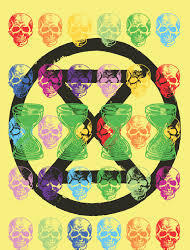
Time against Life Immortality and biblical Winged spirits The most common symbol found, they are usually found on the top of a stone. Adam and Eve Rare carvings of Adam and Eve with an apple tree and snake. Resurrection scenes Bodies rising to heaven clad only in loin cloths Open book Depicting a bible. Flaming torches Representing eternal life. Trades Hammer men All trades which require a hammer such as jewlers and cobblers often use the hammer and crown symbol. Blacksmith An anvil or farrier with a horseshoe and pincers. Tailor Showing pressing iron and shears Gardener Rake, hoe and spade Gamekeeper Gun, powder flask, fishing rod, game bird and dog. Merchant The number 4 is often used to symbolise trading with the four corners of the world and often has crosses added to the arms but sometimes a ship is used to represent overseas trade. Weaver Usually depicted with a weavers shuttle.
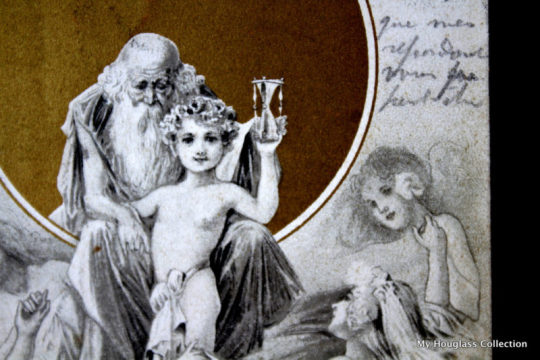
Hourglass 266, post card, Father Time Heraldry Heraldic shields show connections to a noble family but are sometimes used as a way of representing status by including trade symbols within a shield. A Briefer History of Time Stephen Hawking and Leonard Mladinow Foreword THE TITLE OF THIS BOOK DIFFERS by only two letters from that of a book first published in 1988. A Brief History of Time was on the London Sunday Times best-seller list for 237 weeks and has sold about one copy for every 750 men, women, and children on earth. It was a remarkable success for a book that addressed some of the most difficult issues in modern physics. Yet those difficult issues are also the most exciting, for they address big, basic questions: What do we really know about the universe? How do we know it? Where did the universe come from, and where is it going? Those questions were the essence of A Brief History of Time, and they are also the focus of this book. In the years since A Brief History of Time was published, feedback has come in from readers of all ages, of all professions, and from all over the world. One repeated request has been for a new version, one that maintains the essence of A Brief History yet explains the most important concepts in a clearer, more leisurely manner. Although one might expect that such a book would be entitled A Less Brief History of Time, it was also clear from the feedback that few readers are seeking a lengthy dissertation befitting a college-level course in cosmology. Thus, the present approach. In writing A Briefer History of Time we have maintained and expanded the essential content of the original book, yet taken care to maintain its length and readability. This is a briefer history indeed, for some of the more technical content has been left out, but we feel we have more than compensated for that by the more probing treatment of the material that is really the heart of the book. More: The Full History of Time

A bright pink rhinoceros emblazoned with Extinction Rebellions signature logo, next to the chancellery at the Reichstag in Berlin - Current Time Symbol
The Symbolism of Time or Kala and Death in Hinduism
The development of Vedic philosophy was centered around this most important feature of our existence. In fact the Vedas are meant to be a solution to this problem. All the ritual and spiritual practices prescribed in the Vedas are meant to resolve this fundamental problem of our existence. Every religion and tradition that originated int he Indian soil subsequently tried to address in their own ways. The Upanishads, therefore, describe Death as the Lord of creation or creation itself. Our macrocosm (the world), just as our microcosms (bodies) represent Death. The Brihadaranyaka Upanishad (1.2) describes how Death manifested. "In the beginning, there was nothing here whatsoever. Indeed, by Death only all this was enveloped, or by hunger, because hunger is death only. He created the mind thinking, “Let me have a mind.” Then, He performed worship. From that worship, water was produced. He thought, “Truly while I was worshipping, water was produced. That is why water is called Arca. Surely, water comes to him who thus knows why water came to be known as Arca.” Another name give to Death is Kala or time. Time rules our lives. We depart from here when our time comes. The fate of everything in the mortal world is shaped and controlled by Time only. Hence in Hinduism Time or Kala is equated with death. Time is one of the highest aspects of Manifested Brahman. He manifested before the worlds and beings manifested. Hence he is the foremost among the deities. More about The Symbolism of Time or Kala and Death in Hinduism: https://www.hinduwebsite.com/hinduism/essays/kala-death-symbolism.asp#fn01 time traveling symbolism
See also:
Time symbolism, Time is..., The Full History of Time, Time in physics and time Science, Symbolism of Melencolia I by Albrecht Dürer, Time and Text, DADA Time, Text, Time, MHC, Extinction Rebellion - Time against Life, The End of Time, Hourglass and Death on St Thomas’ Church, Hourglass – symbol of Death, Death does not Exist, Hourglass and Skeleton, “Hourglass and Cards” Exhibition, Father and Mother of Time, Time Hub, Time Philosophy, Time synonyms, Qualia and Time Sense, Time perception and Sense of Time, The Hourglass of Emotions, Time Travel + Time Management = Time Travel Management, The Hourglass, Hourglass History, Hourglass symbolism, Hourglass Figure, Hourglass Tattoo, Symbols of Time, Beauty Bio-Net, Father Time Department, Father Time and Mother Nature, Lunar calendar and Moon’s phases, Time Management, Time Management tools MHC SM: MHC Flikr, MHC Pinterest, MHC Facebook, MHC Instagram, MHC YouTube, MHC Twitter
The Hourglass Figure:
MHC Exhibitions: Hourglass Figure Sophia Loren by Adam PierceHourglass Figure Marilyn Monroe About Hourglass Body or Hourglass Figure Hourglass body measurements – body shape online calculator Hourglass Figure Celebrities on MHC Hourglass Figure, the movie MHC hourglass figure workout by Marten Sport Hourglass Figure Department on MHC Virtual Museum https://en.m.wikipedia.org/wiki/Symbols_of_death http://symboldictionary.net/?p=2696 https://www.encyclopedia.com/environment/encyclopedias-almanacs-transcripts-and-maps/symbolic-time ancient-symbols.com/symbols-directory/day_night_symbols.html https://www.iau.org/publications/proceedings_rules/units/ https://www.extinctionsymbol.info Lunar calendar, any dating system based on a year consisting of synodic months A lunar calendar is a calendar based upon the monthly cycles of the Moon’s phases (synodic months), in contrast to solar calendars, whose annual cycles are based only directly upon the solar year. Symbol of Time - The Hourglass See also Time Philosophy and The Full History of Time Read the full article
#alarmclockSymbol#AncientSymbols#ancientsymbolsoftime#AnyResearchisSymbolism#Clocks#Dateandtimesymbols#DeathinHinduism#DíadelosMuertos#Hourglassfact#hourglassfacts#hourglasssymbolism#MeaningofNumbers#multiplicationsign#SandClock#symbolictime#Symbolism#SymbolismofTime#SymbolismofTimeorKala#symbols#SymbolsofDeath#SymbolsofLife#symbolsofwisdom#Synchronicity#Time#Timeconstant#Timeinphysics#TimeResearch#Timesymbolscience#Timesymbolism#timetravelingsymbolism
0 notes
Text
Print December 2020 Calendar Free Printable
It is the essential daily back of the month and you ought to be worried over the new month. You might be started pondering what you have in the coming month. The timetable arrangement is a straightforward and humble way to deal with assistance your standard life. Generally you pick an online timetable arrangement in google and various applications or paper, pen, and scratch cushion. Timetables give various points of interest in school understudies living on the different sides. A calendar makes understudies rout with concentrated on life. Understudies can follow the due dates of noteworthy assignments, adventures, and class tests. calendars can without a lot of a stretch keep your game plans arranged. In the occasion that understudies make an assessment course of action, it invigorates the understudies. Here you get a wide scope of Printable Calendar format as indicated by your choice. Download the December Calendar 2020 great and wonderful arrangement. You can complete all the consistently tasks with it. This timetable is unfathomably valuable. These free printable calendars are open in PDF, Word, Excel Formats.
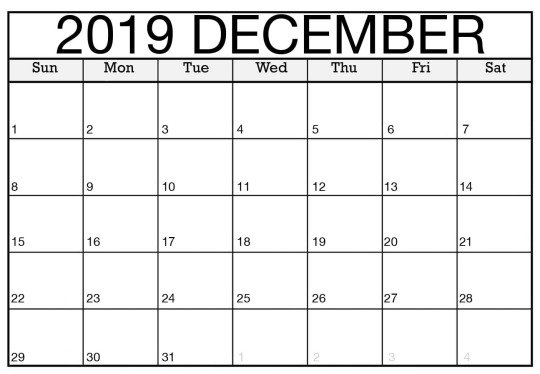
All of the calendars are open in different sizes like HD and 3D position. These are permitted to download as indicated by your need. You can without a doubt confer delightful configurations to your valuable person. Also, get these formats with various game plans. It makes you manage the time and productive features. In the Gregorian Calendar December is the last and twelfth month of the year. This is the essential month of the winter season. In the most settled Roman Calendar, this is the tenth month of the year. Additionally, the name was taken from the Latin " Decem" which means is ten. Most offers happen in the week making ready to Christmas."Jingle Bells" was made in 1857, and not for Christmas – it was proposed to be a thank you song! December begins around a similar time of the multi day stretch of September reliably and completes around a similar time in April reliably. December name is taken from the Latin word Decem (which implies ten) since it was at first the tenth month of the year in the Roman timetable, which began in March.People considered in December are engaging in light of the fact that they have the qualities to convey a spot with their jokes and smiles. They wear that gigantic smile all over as a rule and this is the explanation people start recalling that them.

He has an appealing character and is in like manner incredibly kind. They focus on their obligations very and reliably perform with that smile in all honesty. They fathom the unforgiving reality at a very young age. His affirmation and improvement are significantly commended by individuals around him. Overall Mountain Day is a widespread acknowledgment day and lauded every year on December 11. This day is recognized to Aimed at expecting an occupation in people's lives in the slanting regions and uncovering issues about their noteworthiness to our planet. The mountains are huge for the planet. The mountains are the primary resources of freshwater, sustenance, and imperativeness. Overall Mountains Day is complimented in a startling manner. Climbing affiliations create a one of a kind event for understudies. It's definitely not an open event and most such associations, government workplaces, and post working environments remain open on this day. Today on the web, it is useful for people to find a grouping of December 2020 Calendar options that are available. They are found in different structures and shades. Printable 2020 Calendar can be found in bunches like JPG or PDF or in clear structures. Besides, it is in like manner possible to find plans for structures like, MS Office including Word and Excel. From this time forward, people can pick the right one to fill their need. These timetables enable them to look out for their ordinary events, scan for birthday occasions, and other noteworthy events. Because of clear December 2020 Calendars, they will moreover be available in a collection of plans. People can choose both even similarly as vertical timetables, which can be downloaded in vain out of pocket from the web. Preceding exploring the certified Calendar, people should think about the different systems of timetable that is open, today. Hence, for normal, any absolute plan of calendar offers different dates.

In such way, it is major to make reference to that the cycle of seven days without any other individual's information can't be considered as a plan of full timetable. Regardless, the cycles of a timetable can be composed with irregular marvels, for instance, Solar Calendar, Lunar Calendar and Lunisolar Calendar. Coming to, it should be understood that the extended length of December, allows thirty-one days and will include the twelfth circumstance in a year. Earlier, it had included the tenth circumstance in the Roman calendar till 153 BCE. In any case, as demonstrated by the front line plans like Gregorian and Julian, it is the last and twelfth month of the year. Here the word 'decem' implies ten, which is gotten from the Latin word. Various names by which the month December was insinuated was 'decembre' in Middle English, and in Old English, it was known as month before 'yule.' According to history, at first the length of December was kept short by twenty-nine days. Starting there, around 700 BCE, significant lots of January and February were incorporated. After revamping in the Julian timetable, two days were added to make the length of twenty-nine days to thirty-one days. In the year 2020 timetable, the time of December will be considered as what could be contrasted with June in the opposite side of the equator. This month will reflect the time of winter solstice, and the day will be the briefest in the year. December will be seen as the start of winter season in the Northern Hemisphere.
0 notes